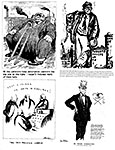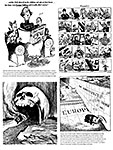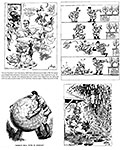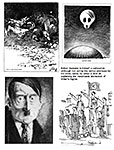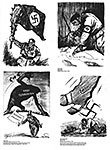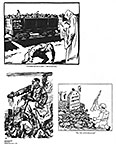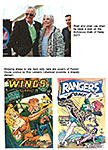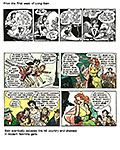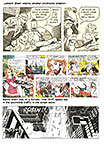 |
||||||||||||||||||||||||||||||||||||||
Opus 369 (August 9, 2017). This time down the rabbit hole, we have a monstrous whopper of a posting. Too much to read at one sitting, kimo sabe: so browse the list that ensues and choose your poison. We have long segments on three of the traditional venues for cartooning— comic strip cartooning with Tina’s Groove’s Rina Piccolo (including some very unconventional early cartoons), editorial cartooning with Pulitzer-winner Jim Morin (plus surveying the editoons of the last month or so), and magazine gag cartooning with Tom Toro of The New Yorker. We also examine the state of the cartooning industry, the emerging surreal weird at The New Yorker, a list of words that should be banned, and the untold history of Uncle Sam. And we review first issues of Jazz Maynard, Jimmy’s Bastard, Normany Gold, and Accell, plus reviews of three books, 20th Century in Cartoons, Hitler in Cartoons, and Cartoons Against the Holocaust. We conclude with affectionate obits for Joan Lee, Bob Lubbers, and “Fabulous Flo.” Yes, it’s too much. Lots of talk about comics. But that’s what we dote on—talk about comics. And here we do enough of it to satiate your appetite for a few days. So scan the following list to find topics that you are most interested in. Here’s what’s here, in order, by department—:
NOUS R US Houston Chronicle Fires Editoonist AAEC Denounces Chronicle and Hearst Sales of Graphic Novels and Comics Still Growing Comics No Longer a Security Threat Trump Quotes in Superhero Comic Conservative Economic Policy Fails
Tina Loses Her Groove Piccolo at Rhymes Vintage Piccolo Toons
IN THESE UNITED STATISTICALS Facts
ODDS & ADDENDA No Comics in EW Report on Comic-Con Pooh Banned in China Spider-Man Art on Display
WORD POWER List of Words That Should Be Banned
Twump and Pooty: New Comic Strip
PULITZER WINNER REFLECTS
Tangled Tale of Uncle Sam
THE STATE OF THE CARTOONING INDUSTRY
SURREAL WEIRD CARTOONS AT THE NEW YORKER The New Regime Sets In
The New Yorker’s Tom Toro Interviewed With Sampling of His Cartoons (Particularly anti-Trumpet)
FUNNYBOOK FAN FARE First Issues of—: Jazz Maynard Jimmy’s Bastard Normandy Gold Accell
EDITOONERY The Month’s Antics in Political Cartoons
THE FROTH ESTATE What Roger Ailes Wrought
NEWSPAPER COMICS PAGE VIGIL Transpirings of the Last Month Or So
BOOK MARQUEE Short Reviews Of—: The Saint: The Man Who Was Clever The 20th Century in Cartoons Hitler in Cartoons Alan Moore’s Last Comic Book Two More Harry Potter Books
BOOK REVIEW Long Analysis and Verdict On—: Cartoons Against the Holocaust ONWARD, THE SPREADING PUNDITRY Mass Murder Stats
PASSIN’ THROUGH Appreciative Obits for—: Joan Lee Bob Lubbers Fabulous Flo Steinberg
QUOTE OF THE MONTH If Not of A Lifetime “Goddamn it, you’ve got to be kind.”—Kurt Vonnegut
Our Motto: It takes all kinds. Live and let live. Wear glasses if you need ’em. But it’s hard to live by this axiom in the Age of Tea Baggers, so we’ve added another motto:. Seven days without comics makes one weak. (You can’t have too many mottos.)
And our customary reminder: don’t forget to activate the “Bathroom Button” by clicking on the “print friendly version” so you can print off a copy of just this installment for reading later, at your leisure while enthroned. Without further adieu, then, here we go—:
NOUS R US Some of All the News That Gives Us Fits
HOUSTON CHRONICLE FIRES THE LAST STAFF EDITOONIST IN TEXAS Pulitzer Prize winning editorial cartoonist Nick Anderson was fired in mid-July as a cost-cutting measure by the Houston Chronicle, where Anderson had been the full-time staff editoonist since 2006. The year before, while cartooning at the Louisville Courier-Journal, he was awarded the Pulitzer, credited for his “unusual graphic style that produced extraordinarily thoughtful and powerful messages.” My recollection is that the Texas paper went looking for a cartoonist to replace Clyde Peterson, who was retiring after 41 years with the Chronicle—and Anderson, the most recent Pulitzer-winner, looked like a good replacement for the paper’s popular veteran. Anderson, 56, is taking this reversal of fortunes remarkably well. “The odds caught up with me,” he wrote on Facebook, alluding to the decades-long thinning of the ranks of full-time staff editoonists in America. With his departure, only about 48 editorial cartoonists work full time on the staffs of daily newspapers; that number was 101 just 9 years ago. “Ironically,” Anderson continued, “thanks to social media, my cartoons are seen more widely than ever. While the Internet and social media help spread my work widely, they also have made it harder for anyone in the news business to make a living. I was able to drive significant traffic to my employer’s website at times, but not on the same scale as the Facebook traffic. And traffic alone isn’t enough anymore. Newspapers are moving to a subscriber/paywall model. Unfortunately, the powers-that-be decided a full-time cartonist was not going to be a part of that model at the Chronicle. “I’ve had a good run,” Anderson finished, “and I’m grateful to have been a political cartoonist for so long. I’ve been extremely fortunate in my professional career. I really want to thank my readers for their encouragement, comments, and feedback. Even the insults and disagreements have been appreciated.” He will continue to draw editorial cartoons for his syndicate, the Washington Post Writers Group, which distributes them to more than 100 newspapers. But the resulting income is scarcely a living wage. Anderson began editooning at Ohio State University. While majoring in political science, he cartooned at the campus newspaper, the Lantern. In 1989, he won the Charles M. Schulz Award for best college cartoonist. He interned one summer with the Courier-Journal, which immediately recognized his talent. The newspaper created a position for him as an associate editorial cartoonist and illustrator after his 1991 graduation from OSU. “I didn’t want Nick to get away and get ensconced someplace else because he just seemed to fit us,” says David Hawpe, editorial director of the paper. “I think he has the kind of tone we want for our page – it’s a tone that’s not disrespectful, but it is provocative.” Anderson was promoted to chief editorial cartoonist in 1995. In
addition to the Pulitzer Prize, he won the Society of Professional Journalists'
Sigma Delta Chi Award in 2000, the 2011 National Press Foundation's Berryman
Award, and two-time winner of the John Fischetti Award from Columbia College
Chicago in 1999 and 2012. And he also earned recognition for his drawing style. Anderson has pioneered a method of coloring his cartoons. Using an advanced computer program, he creates digital paintings characterized by subtle textures and striking images. Because of his innovative use of the program, its manufacturer, Corel Corporation, has designated Anderson a "Painter Master." Anderson was president of the Association of American Editorial Cartoonists in 2007-2008. And his AAEC colleagues have scarcely forgotten him at this turning point in his career—:
AAEC Denounces Chronicle and Calls Anderson Firing Misguided As soon as Anderson’s lay-off became known, the Board of Directors of the AAEC released a statement on Nick Anderson and his firing—: The firing of Pulitzer Prize winning editorial cartoonist Nick Anderson is a misguided, short-term cost-cutting maneuver by the Houston Chronicle and Hearst Communications. The elimination of his position now means there isn't one on-staff newspaper editorial cartoonist in the entire state of Texas to provide local visual commentary and hold the state government accountable to its citizens. Editorial cartoonists are a historically important and powerful component of American journalism. Editorial cartoons are very popular with readers; they look to their local cartoonist to provide satirical observations of their representatives and government officials. Especially in these times where our country's free press is under attack by the current administration, the work of editorial cartoonists resonates with Americans and provide a vital component of the political dialogue that our democracy needs in order to thrive. While we acknowledge the financial challenges publishers face with the online market, eliminating original content is not the answer. We denounce the actions of Hearst Communications in their short-sighted cost cuts at the expense of the health of the editorial cartoonist profession and journalism in general." The statement was signed by AAEC President, Ann Telnaes; President-Elect, Pat Bagley; Vice President, Nate Beeler; Secretary-Treasurer, Monte Wolverton; and Immediate Past President, Adam Zyglis and Board Members 2016-2018: Edd Hall, Keven Siers, and Signe Wilkinson (a list that includes several Pulitzer winners.)
SALES OF GRAPHIC NOVELS AND COMICS STILL GROWING By Calvin Reid, publishersweekly.com Combined graphic novel and comics sales in North America grew 5% to $1.085 billion in 2016, a $55 million increase over the $1.03 billion reported last year, according to a joint estimate by industry news sites Comichron and ICv2.com Led by the continuing sales growth of book-format graphic novels (which rose to $590 million, from $350 million in 2015), the $1.085 billion figure represents the combined sales of book-format graphic novels, traditional comics periodicals ($405 million), and digital download-to-own comics ($90 million). Physical sales of graphic novels sold through the book trade rose 16%, to $405 million. While total sales of both comics and books through the comics shop channel were about $570 million, the increase was driven by periodical sales. Sales of graphic novels in the comics shop market were flat in 2016, according to the joint report. Milton Griepp, CEO of pop culture new site ICv2.com, cited the ongoing growth of graphic novels as key to the increase: "This represents growth in the broadest part of the market, where increased variety of content is being found by new audiences for comics, including kids and women."
COMIC BOOKS NO LONGER A SECURITY THREAT The Transportation Security Administration has ended tests of a new requirement for passengers to remove books and other paper items (including comic books) from their carry-on luggage during security screening, reported Maren Williams at CBLDF. Rules demanding this sort of search may be instituted at a later date, but, said an agency spokeswoman, “at this time, [we] are no longer testing or instituting these procedures.” The TSA says that the pilot test simply ran its course, but the announcement came shortly after alarm bells started ringing among intellectual freedom and privacy advocates in the past week—particularly at the San Diego International Airport to which thousands of comics fans were flocking with their bags loaded with comic books purchased during the San Diego Comic-Con. Turns out to have been a misreading of some obscure directive somewhere. Separately in a public-facing blog post, the agency said that pilot tests had been conducted and subsequently ended at only two airports. It then made some curious attempts at humor in dismissing privacy concerns (in italics): [O]ur adversaries seem to know every trick in the book when it comes to concealing dangerous items, and books have been used in the past to conceal prohibited items. We weren’t judging your books by their covers, just making sure nothing dangerous was inside. In any case, the TSA says that as of today there is no systematic requirement for books to be scanned separately in any U.S. airport, nor does it currently have plans to implement any such procedure. And where’s the funny part? I guess you had to be there.
TRUMP QUOTES TO BE USED IN NEW SUPERHERO FUNNYBOOK The Unquotable Trump comic book, due for November publication, was briefly displayed at the San Diego Comic-Con a couple weeks ago by its creator, Robert Sikoryak, who has made a reputation for himself doing comic book mockeries of famous literary and/or actual personages. “He’ll take a famous novel, such as Crime and Punishment, and draw it in the style of Batman artist Bob Kane,” reported Peter Larson at ocregister.com. “The resulting mash-up was Dostoyevsky Comics.” Now
he’s given Trump the treatment in a comic book of comic book covers. For it,
Sikoryak pulled actual quotes from Prez Trump on the campaign trail and in
office, using them to create parodies done in the style of vintage comic book
covers. On one the cover of which looks like a Wonder Woman comic book, below the Nasty Woman logo, Wonder Woman is shown knocking Trump off the top of a wall, and as he tumbles head over heels, he utters his famous utterance about nasty woman, his cell phone flying. The Trump quotes are sourced at the back of the book. “I usually work with found text,” said Sikoryak, “—and I’d been confounded and outraged by everything he’d said during the campaign. I used only things he said out loud. None of his tweets.” Has he considered send a copy to the White House? asked Larson. Said Sikoryak: “I guess we should send one to Sean Hannity—that way Trump might see it.”
THE ACTUAL RESULTS OF IMPLEMENTING THE CONSERVATIVE AGENDA From The Week “The nation’s most aggressive experiment in conservative economic policy is dead,” said Russell Berman at TheAtlantic.com. In 2012, Kansas Governor Sam Brownback put the theory of supply-side economics into action, making sharp reductions in the state’s income tax rates and virtually elminiating taxes on small businesses. Like all supply-siders, he was convinced deep tax cuts would accelerate economic growth so much that they would pay for themselves. But that didn’t happen. Growth rates in Kansas have lagged way behind national levels, the budget has a $900 million two-year shortfall, and education spending was cut so badly that parents rebelled and the state Supreme Court ordered funding restored. The state’s Republican lawmakers finally rebelled and overcame Brownback’s veto to raise taxes by $1.2 billion. Supply-side economics “never works,” said Eugene Robinson in the Washington Post. Before this debacle, Republicons “could at least argue” that their theory had never been fully tested. Now “that excuse is gone.” Excuse-makers, however, presisted. As they always do. Here we go again, said Pat Garofalo in USNews.com. Conservatives always try to explain away supply-side failures by saying the reforms weren’t quite right [or the timing was wrong or...]. “No amount of evidence is enough to shake the belief that America is just one good rate reduction away from an economic renaissance.” The big question is whether national Republicons will heed the lessons of Kansas, said Jordan Weissmann in Slate.com. Prez Trump is being advised by the same economists who engineered Brownback’s disastrous scheme, and he has proposed a similar program of massive income tax cuts and pass-through exceptions for businesses. “Kansas has admitted its mistake”—but Republicons “may try to repeat it anyway.”
TINA LOSES HER GROOVE Rina Piccolo’s syndicated comic strip, Tina’s Groove, ended a 15-year run on July 2. Debuting on March 4, 2002, the strip struck a blow for single women. It chronicled “the personal and workplace adventures of a single, smart, attractive waitress who worked at Pepper’s Fine Dining restaurant,” said King Features at its website. “Shrewdly self-aware, Tina refuted cliched notions of single women as neurotics obsessed with career or marriage. Tina found her groove and empowered herself by embracing life and everyone she met head-on. She’s happy being Tina, living life rather than waiting for it to begin. She is described as ‘smart, funny and real,’ an everywoman in her 30s who ‘struggles to deal with her job, dating and the ups and downs of day-to-day living.’" In contrast, Suzanne, Tina’s best friend and a fellow waitress, “is always looking for a good time and enjoys casual relationships with a large number of men.” Said Piccolo of Trina and Suzanne: “Tina’s imperfections, if she has any, are of the kind that are quirky, and therefore endearing. This is good for a cartoon character. I believe the main character of a comic strip should be one that’s likable. But does that mean the main character should be flawless? It’s the weaknesses, or fixations, that make characters interesting. The other characters of the strip all have fixations that make them imperfect. The chef Carlos, known for his ego and his outdated views on gender and romance, is a sack of testosterone who must prove himself to be the manliest at any cost. Suzanne is a spoiled 30-something flake who has so many weaknesses she’s created a personality out of being less than perfect.” Tina has a boyfriend, Gus, whom she met in 2012; but she displays no eagerness to join the ranks of marital bliss. She’s just self-sufficient unto herself. But Piccolo, although abandoning Tina, hasn’t given up syndicated strip cartooning. In an online blog post, Piccolo laid out how it came together: "Every now and then, it happens. You reach a point in your career at which big decisions need to be made, a sort of crossroads, I guess you’d call it. This point came to me about two years ago. At the time, I was in my 13th year of Tina’s Groove. I was working on other things as well: completing my co-authored book Quirky Quarks, drawing cartoons for my Wednesday slot of the single panel daily Six Chix, and also, I was writing some gag ideas for Hilary Price, for her comic strip Rhymes With Orange (while occasionally filling in for her as a Guest Cartoonist). “It was around this time that Hilary approached me with an idea of her own. That idea — a tiny pebble that took 24 months to develop into a boulder— changed my life. Basically, Hilary asked if I would join her in drawing and writing Rhymes With Orange. And I said yes." The week of July 3 marked the official launch of that collaboration. In 15 years, Piccolo wrote, she produced more than 5,700 Tina’s Groove strips. For 16 years, she also has contributed a regular daily installment to the unique strip, Six Chix, through which six women cartoonists rotate, each doing one strip a week. Piccolo withdrew from that arrangement last year.
TRINA’S GROOVE LEAVES THE DAILY FUNNY PAGES of the nation’s newspapers with a quirky flourish. Piccolo teased her readers: “Have I failed in giving enough hints? Maybe you suspected that something was up, but then maybe you didn’t ... until today,” she added on July 2. “To all of you who have said goodbye to Tina, whether on social media or to me directly, I just want to say that I very much appreciate your kind words and warm wishes, and am sending virtual hugs to each and every one of you,” Piccolo wrote. “For those of you who have not been so kind towards my decision to end Tina’s Groove, well, what would you like me to tell you? I’m sorry that I’ve made a career change that doesn’t sit well with you. In my next life I will try to make decisions catered more to your liking. (Sheesh.)” For the last several weeks, Tina’s Groove has been an unusual strip. Piccolo explained: “With the knowledge that these were to be my last months of writing and drawing the strip, I went a little crazy toying with it, and decided to break some walls and have some fun with themes that would’ve been out of place if I’d done them before.” We’ve posted a selection of these odd-ball dailies next down the scroll. I enjoyed Tina’s Groove, but I enjoyed Piccolo’s earlier work better. When I first met her at the San Diego Comic-Con years ago—before Tina’s Groove—she was selling a little booklet of cartoons at a table in the small press area. The cartoons were sharply witty and off-the-wall. Tina’s Groove, in contrast, was wholly conventional however pioneering its approach to working single women was. I always thought that syndication had blunted the cutting edge of Piccolo’s sense of humor—as if she had to hold something back in order to appear in a daily newspaper. Hilary Price often ventures into areas Tina never wandered—and the times are more permissive now for off-beat comedy. I’m looking forward to seeing that early side of Piccolo in Rhymes with Orange. And now, a selection of the strips of Tina’s farewell bow. And several of Piccolo’s first week on Rhymes. Then we’ve posted samples of Piccolo’s outrageously funny iconoclastic single-panel cartoons from three pre-syndication collections: Stand Back, I think I’m Gonna Laugh (1994), Kicking the Habit: Cartoons about the Catholic Church (1996), and Rina’s Big Book of Sex Cartoons (1997).
IN THESE UNITED STATISTICALS ◆ Ten times more people work in clean energy in California than mine coal in the entire country reports the New Republic (August/September 2017). So by reviving the coal industry, the Trumpet effectively ignores the direction that the development of clean energy growth is taking us. ◆ Since January, nine states have passed major new voter restrictions that will hit minorities and students hardest; again, the aforementioned issue of the New Republic. ◆ In a survey of Americans in small towns and rural areas, 68% of respondents say that their values are different from those of people in urban areas; 56% of rural Americans believe that the federal governments aids people in cities more than them, and 78% of rural Repbulicans said Christian values are under attack (Washington Post/Kaiser Family Foundation). Most of these folks are likely consumers of Fox News. (Sorry: that’s just moi—RCH.)
ODDS & ADDENDA The August 4th issue of Entertainment Weakly carried its post Sandy Eggo report: nine (9, count ’em) pages about movie stars; nowhere in this so-called “coverage” were “cartoonist” or “comics” mentioned, except the latter in the singular form of “Comic-Con.” ... Images of Winnie the Pooh have been blocked on social media sites in China because bloggers are jokingly comparing the plump bear to China’s president. ... The Society of Illustrators clubhouse at 128 East 63rd Street in New York has mounted the first ever exhibition of original Spider-Man artwork by John Romita and other significant artists including Steve Ditko, Todd McFarlane, John Buscema, Ross Andru, Gil Kane, Ron Frenz, Keith Pollard, John Romita Jr. and others. The exhibit runs from June 6th through August 26th, 2017.
Fascinating Footnit. Much of the news retailed in the foregoing segment is culled from articles indexed at https://www.facebook.com/comicsresearchbibliography/, and eventually compiled into the Comics Research Bibliography, by Michael Rhode, which covers comic books, comic strips, animation, caricature, cartoons, bandes dessinees and related topics. It also provides links to numerous other sites that delve deeply into cartooning topics. For even more comics news, consult these four other sites: Mark Evanier’s povonline.com, Alan Gardner’s DailyCartoonist.com, Tom Spurgeon’s comicsreporter.com, and Michael Cavna at voices.washingtonpost.com./comic-riffs . For delving into the history of our beloved medium, you can’t go wrong by visiting Allan Holtz’s strippersguide.blogspot.com, where Allan regularly posts rare findings from his forays into the vast reaches of newspaper microfilm files hither and yon.
FURTHER ADO “He has so many questions that trying to follow his thoughts is like trying to follow a bag of spilled marbles.”—Time profile of Michael Keaton Woody Harrelson has led a life that is often full of trouble—mostly of his own making. But he doesn’t have many regrets: “It’s like my buddy says, ‘If you’re not living on the edge, you’re taking up too much room.’”
WORD POWER Annual List of Banned Forever Words The wordsmiths at Lake Superior State University have taken their best "guesstimate," and early in 2017, they released LSSU's 42nd annual List of Words Banished from the Queen's English for Mis-use, Over-use and General Uselessness. As a user of words myself, I find the ensuing report fascinating—and highly amusing. Skip this if you’d rather look at pictures (which is usually my choice, but, in this case ...). "Overused words and phrases are a 'bête noire' for thousands of users of the 'manicured' Queen's English," said an LSSU spokesperson, who released the 'historic' list during a town hall meeting. "We hope our modest 'listicle' will figure 'bigly' in most 'echo chambers' around the world." LSSU's word banishment tradition is now in its fifth decade, according to the University’s press release [which is responsible for all of this verbiage]. Through the years, LSSU has received tens of thousands of nominations for the list, which now includes more than 850 entries. This year's list is culled from nominations received mostly through the university's website. Word-watchers target pet peeves from everyday speech, as well as from the news, fields of education, technology, advertising, politics and more. A committee makes a final cut in late December. Compilers hope this year's list is "on fleek." Herewith, the 2017 list: You, Sir - Hails from a more civilized era when duels were the likely outcome of disagreements. Today, we suffer on-line trolls and Internet shaming. Focus - Good word, but overused when concentrate or look at would work fine. See 1983's banishment of, We Must Focus Our Attention. Bête Noire - After consulting a listing of synonyms, we gather this to be a bugbear, pet peeve, bug-boo, pain, or pest to our nominators. Town Hall Meeting - Candidates seldom debate in town halls anymore. Needs to be shown the door along with "soccer mom(s)" and "Joe Sixpack" (banned in 1997). Post-Truth - To paraphrase the late Senator Daniel Patrick Moynihan, we are entitled to our own opinions but not to our own facts. Guesstimate - When guess and estimate are never enough. 831 - A texting encryption of, I love you: 8 letters, 3 words, 1 meaning. Never encrypt or abbreviate one's love. Historic - Thrown around far too much. What's considered as such is best left to historians rather than the contemporary media. Manicured - As in a manicured lawn. Golf greens are the closest grass comes to being manicured. Echo Chamber - Lather, rinse, and repeat. After a while, everything sounds the same. On Fleek - Anything that is on-point, perfectly executed, or looking good. Needs to return to its genesis: perfectly groomed eyebrows. Bigly - Did the candidate say "big league" or utter this 19th-Century word that means, in a swelling blustering manner? Who cares? Kick it out of the echo chamber! Ghost - To abruptly end communication, especially on social media. Is it rejection angst, or is this word really as overused as word-banishment nominators contend? Either way, our committee feels the pain. Dadbod - The flabby opposite of a chiseled-body male ideal. Should not empower dads to pursue a sedentary lifestyle. Listicle - Numbered or bulleted list created primarily to generate views on the Web, LSSU's word-banishment list excluded. "Get your dandruff up . . . " - The Committee is not sure why this malapropism got nominators' dander up in 2016. (I love this one.—RCH) Selfie Drone - In what could be an ominous development, the selfie— an irritating habit of constantly photographing and posting oneself to social media— is being handed off to a flying camera. How can this end badly? Frankenfruit - Another food group co-opted by "frankenfood." Not to be confused with other forms of genetically modified language. Disruption - Nominators are exhausted from 2016's disruption. When humanity looks back on zombie buzzwords, they will see disruption bumping into other overused synonyms for change.
THE BANNISHED WORD LIST BEGAN on New Year’s Day in 1976 when LSSU Public Relations Director W.T. (Bill) Rabe released the first one. The international reaction was so enthusiastic that Rabe was sure the annual listing “would go on forever." So it seems. People from around the world have nominated hundreds of words and phrases such as "you know," "user friendly," "at this point in time," and "have a nice day," to be purged from the language. The tongue-in-cheek Banishment List began as a publicity ploy for little-known LSSU. In 1971, Rabe realized that Lake State was still largely thought of as a branch of Michigan Technological University, if it was known at all. To combat this image, he established the mythical Unicorn Hunters, along with events such as the annual Snowman Burning to welcome the first day of spring and, in 1976, the nefarious list of words. In order to gain the most media coverage possible, the Banishment List is released each year on New Year's Day. This is attributed to former newsman Rabe's knowledge of the press. New Year's Day is traditionally a slow news day so newspapers and tv news and the lot will publish almost anything to fill columns and air time. The first list was dreamed up by Rabe and a group of friends at a New Year's Eve party in 1975. Though he and his friends created the first list from their own pet peeves about language, Rabe said he knew from the volume of mail he received in the weeks after posting the first list that the group would have no shortage of words and phrases from which to choose for 1977. Since then, the list has consisted entirely of nominations received from around the world throughout the year. After Rabe retired in 1987, the University copyrighted the concept and continued the tradition. For the sake of one more footnote— LSSU’s burning of a massive paper snowman at high noon on the first day of Spring is a ceremony that welcomes the seasonal change. Members of the student government barbecue hot dogs and serve them to the students and guests as part of the celebration. The first spring snowman burning was held in March 1971 by the Unicorn Hunters, a former campus club that is another of Rabe’s inventions. Traditionally it has been held on the first day of spring to bid good-bye to winter and welcome spring. LSSU's snowman has taken on many shapes over the years. During the 1970s, when women's liberation was a news issue, a "snow person" was burned. In the 1980s, when clones and "cloning" were first in the news, a "snow clone" was torched. The Unicorn Hunters also burned a Snow Ayatollah Khomeni during the Iran hostage crisis. In the late 1980s, the snowmen began to take the form of a Lake State rival hockey team, usually whichever team the Lakers were playing that weekend. This was dropped after a few years when many complained that it brought bad luck to the team. Snowmen are made out of wood, paper destined for the recycling bin, along with some straw, wire and some paint. They are usually husky and stand 10 to 12 feet tall.
TWUMP AND POOTY: THE STORY TO DATE
FAX & SMACKS ◆ Donald Trump is the first U.S. Prez without a pet since Andrew Jackson, who left office in 1869, reports The Economist. Well, that figures: how could our most narcissistic Prez have any room left in his yuuuge self-regard for affection for anything outside himself? ◆ The American Psychoanalytic Association has abandoned a long self-enforced custom. It has informed its members that they are now free to publicly offer their opinions on the mental health of the Trumpet, “since Trump’s behavior is so different fro anything we’ve ever seen.” ◆ The only arguably major legislation passed by Congress on the Trumpet’s watch was when Congress agreed to a $1 trillion spending package in early May, but the package did not include most of the Trumpet’s policy initiatives, reported The Week (May 12; I’m a little late with this, but I’ve been saving it up). The only loser was Trump.
PULITZER WINNER REFLECTS ON HIS CARTOONING CAREER By Jim Kanak at seacoastline.com For most
journalists, winning a Pulitzer Prize is a crowning lifetime achievement.
Ogunquit resident Jim Morin, editorial cartoonist at the Miami Herald since 1978, reached that goal in 1996, winning his first Pulitzer. Then, in
April of this year, he won his second, based on a juried review of a portfolio
of 20 cartoons he selected and submitted from his work in 2016. (See Opus 365.) “This one was really unexpected,” Morin said in an interview at his home. “Coming at the end of a career, it’s really rewarding, an acknowledgment that you’re still doing good work.” Morin began his political cartooning in his days at Syracuse University working on the student newspaper. “I went to art school at Syracuse,” Morin said. “I took figure drawing and painting classes. I loved cartooning, but saw that you needed an art background to pull it off.” Morin’s interest in politics blossomed during the Watergate scandal that resulted in President Richard Nixon’s resignation from office in 1974. Morin was in London as the scandal unfolded and noted that the British people he met all expressed interest in what was happening in the United States. When he returned to the states, Morin said he attended some of the trials “to get a real look at what was going on.” He decided to see if the student newspaper had any interest in his doing editorial cartoons. “My mom was really nervous about my making a living with an art degree,” Morin said. “She said ‘why don’t you do what (political cartoonist) Herblock does?’ I looked at some of it and started to do it. When I returned to Syracuse, I was going to ask if I could draw political cartoons for the student paper, but before I could, the editor asked if I wanted to. I started at two a week and ended up at five. That was a stroke of luck. I learned how to cartoon by looking at other cartoonists. Duncan McPherson of the Toronto Star was an amazing artist. I never stopped and still look at other people.” Morin’s interest in cartooning and art began early in his youth, and was influenced by an acquaintance with iconic cartoonist Al Capp. “I came from a political family,” said Morin. “My dad was involved in the Republican Party in Massachusetts. The Republicans wanted someone to run against (Democratic Senator) Ted Kennedy, and they came up with Al Capp. My dad was his campaign manager. It didn’t last long. Capp went down to register (as a candidate) and he was a day late.” Despite the campaign ending prematurely, Morin’s father had arranged for him to spend some time with Capp. “I went to his studio on Beacon Street and went to lunch at the Ritz Carlton,” Morin said. “He asked (what artists) I followed and I said Daumier, the French caricaturist. Capp said that’s a good one to be influenced by. I was into caricature at that point, and followed people like Edward Sorel, David Levine, and Ralph Steadman.”
ARMED WITH HIS PORTFOLIO from his days at Syracuse, Morin pursued a professional career in the early 1970s. He spent at year freelancing and then landed a job with a newspaper in Texas. He left after a story and cartoon about a local business caused the business to pull its advertising from the paper, resulting in the editor’s departure. “That was my first lesson in newspapering,” Morin remembered. He spent a brief time with the Richmond (Virginia) Times Dispatch, where he worked with editoonist Jeff McNelly, who also did the comic strip Shoe. Morin heard of an opening at the Miami Herald and was hired there in 1978, a position he’s maintained ever since. He and his wife, author Danielle Flood, moved to Ogunquit four years ago, and he’s been working from his office there since. “The Herald moved its offices from Biscayne Bay inland to a smaller building,” Morin said. “I decided to work from home. Myriam Marquez was the editor, a wonderful one. She said it was fine for me to work from home. I’ll never forget her for that.” Morin produces roughly 350 cartoons each year, dealing with national as well as statewide issues. “I like cartoons that have legs, that are understandable now and even years from now,” he said. “I don’t particularly like election years, dealing with personalities. I like dealing with issues that mean something.” At this point in his career, Morin said he’s winding down, looking to retire in 12 to 18 months. That doesn’t mean his days as an artist will end. He’s also been painting since he was young, primarily working in oils and, more recently, watercolors. “I’ve been doing it since I was a kid, but always in addition to something else,” Morin said. “I look forward to doing it in retirement. Watercolors are really a different thing. It will take me a number of years to get them where they’re good. It’s a challenge, like being young again.”
THE TANGLED TALE OF UNCLE SAM The history of the cartoon figure who represents the United States of America is, itself, a sort of symbolic encapsulation of cartooning: Uncle Sam evolved by blending the verbal and the visual like any good cartoon. First came the verbal, which emerged during the War of 1812. The story, though disputed, is that the term “Uncle Sam” referred, at first, to a businessman in Troy, New York, Samuel Wilson, who was affectionately known as “Uncle Sam” Wilson. He inspected beef and pork purchased for the government during the War. The barrels of meat were stamped “U.S.” to indicate government property. They were also stamped “E.A.,” the initials of the contractor, Elbert Anderson, who purchased provisions. His workmen understood what “E.A.” meant—the name of their boss— but wondered who “U.S.” was. Some wag supposedly supplied a facetious explanation: the initials stood for Uncle Sam, from whom Anderson bought the meat. “Uncle Sam” meaning the United States appeared in newspapers from 1813 to 1815; in 1816, he appeared in a book in that symbolic role. By the 1820s, “Uncle Sam” was often being used as a term for the United States. The Sam Wilson connection seems a little shaky to me, but Congress passed a resolution in 1961 that recognized “Uncle Sam” Wilson as the namesake of the national symbol. The visual representation of Uncle Sam, a tall man with a white goatee wearing a top hat, swallow-tail coat and striped trousers, evolved from pictures of an earlier symbolic figure—Brother Jonathan.
UNTIL THE CIVIL
WAR, goateed Brother Jonathan, in striped pants and top hat, often stood for
the United States even though the cartoon character initially represented just
New England. The term Brother Jonathan originated during the English Civil War
(1642-1651) between the Parliamentarians (“Roundheads”) and the Royalists
(“Cavaliers”) as a somewhat derogatory name for the Puritan Roundheads, and
then the name was also applied to the New England colonists, who were also
mostly Puritans who also supported the Parliamentarians in the mother country.
By this route, Brother Jonathan became a stock character that good naturedly
lampooned Yankee acquisitiveness and other crafty peculiarities attributed to
citizens of the region. A weekly newspaper called Brother Jonathan was first published in 1842 in New York, exposing the character to parts of the country outside New England. And in 1852, a humor magazine, Yankee Notions, or Whittlings of Jonathan’s Jack-Knife, gave the character additional visibility. According to St. Wikipedia, about this time, the New England-based Know Nothing Party, which Yankee Notions lampooned, was divided into two camps—the moderate Jonathans and the radical Sams. Eventually, over the course of the late 19th century, Uncle Sam displaced Brother Jonathan by assuming his customary garb— top hat, tails, striped pants plus goatee. According to an article in The Lutheran Witness of 1893, Brother Jonathan and Uncle Sam were two names for the same person. “When we meet him in politics, we call him Uncle Sam; when we meet him in society, we call him Brother Jonathan.” I suspect that such a fine distinction had a very short life—if, in fact, it survived anywhere outside the pages of The Lutheran Witness. At Harper’s Weekly through the 1870s, we can watch the evolution of Brother Jonathan into Uncle Sam under the pencil of Thomas Nast. In May 1871, the character, named Jonathan in his encounter with Britain’s John Bull, seems somewhat scruffier in appearance than in his Uncle Sam incarnation. By April 1876, Uncle Sam (dubbed “U.S.” by Nast) has acquired a rather dignified aspect, which he will retain thereafter.
Some sources say that Yankee Doodle Dandy is somehow incorporated into Uncle Sam, but I don’t agree: Yankee Doodle Dandy appeared only in the lyrics to a song—no pictures— and neither Brother Jonathan nor Uncle Sam reflect any of his lyric personality. Brother Jonathan had long since disappeared by the dawn of the Twentieth Century, and when famed illustrator James Montgomery Flagg (using his own face as a model) painted Uncle Sam’s portrait for a recruiting poster during World War I, Uncle Sam was firmly established as a symbol for the United States. The Flagg interpretation and numerous other renderings of Uncle Sam conclude this foray into the patriotic past. All the pictures posted near here come from a collection of Uncle Sams owned by a Florida editorial cartoonist Bob Meagher (1913-1994). They were assembled and published in 1998 in America’s Favorite Uncle: Cartoonists Draw A Legacy (Calm Publications, Milton, Florida). If you keep an eye on the signatures as you browse this gallery, you’ll see some names famous in the history of cartooning—Zim, for instance, and editoonists Fred O. Seibel and Cecil Jensen, and the founder of the Landon Correspondence School of Cartooning not to mention the creator of Pogo. How many others do you know of?
MOTS & QUOTES So leaders in the Republicon Congress continue to support the Trumpet and tolerate his uncooth and ill-considered antics in the belief that, as Prez, he’ll sign into law whatever wild-eyed right-wing legislation they pass. Party loyalty. Right. Like Trump is reliable. He’s always done whatever the GOP expects him to do, right? And he always keeps his promises. Right. Are those guys all nuts? Well, yes. But we’ve known that for years, haven’t we?
THE STATE OF THE CARTOONING INDUSTRY The Internet is clearly one of the futures of cartooning. But since at present there are no gatekeepers (like feature syndicate cartoon editors), the quality of the work is iffy. Some excellent stuff is being done. Sinfest, a daily strip by Tatsuya Ishida, has been regaling us with its quirky humor since January 2000. And there are a few others. Mostly, however, web comics are pretty sad graphically speaking, and the humor evades me more often than not. (More my problem than theirs, no doubt.) Still, the web is a good place to train, and it’s lively in that apprentice function. Magazine cartooning has been fading ever since the collapse of the Saturday Evening Post as a weekly publication in 1963. Other great venues for gag cartooning—Collier’s, Look, Saturday Review, etc.—joined the SEP at about the same time, late 1950s–1960s. And when Playboy stopped publishing cartoons in March 2016, that left only The New Yorker as a major market for gag cartooning. Other markets exist (consult Gag Recap website to get a start at a list; also Google magazine markets for freelance cartoons), but the pay is so low I doubt anyone can make a living cartooning for magazines. The liveliest place for good cartooning these days is comic books. And it’s not just superhero antics by overwrought anatomies in tighty whities. All sorts of grim adventuring and light-hearted joking and wild fantasizing is going on, and new titles on different milieux pop up every month; some don’t last long, but other new endeavors quickly take their places. And the artwork is usually superior—take, f’instance, the exquisitely detailed and realistic rendering by Sean Phillips (colored masterfully by Elizabeth Breitweiser) in Ed Brubaker’s Kill or Be Killed, or any of the comic books reviewed below in Funnybook Fan Fare. The gratifying growth of the graphic novel has further stimulated the print medium in both art and story. As for the newspaper comic strip, its fate is tied to the fate of newspapers, and while the prospects at present don’t seem, offhand, very encouraging, the situation is better than it seems. I inveighed against the fake death of newspapers in Opus 318 (November 2013), so I won’t repeat myself here. But there are a couple more things I can add to that. First, new comic strips continue to be created. Not as many as in the fond days of yesteryear, but new strips signal that there is life left in the medium. Second, newspaper circulation, which has been declining alarmingly since the advent of the Web, is reviving and doing better than supposed. Oddly, the election of the Trumpet has resulted in a surge of newspaper subscriptions. In the week after the election, the New York Times netted 41,000 new subscribers, according to a Huffington Post report; in the two days after Election Day, the Times website got record traffic, and readers spent five times longer on the site than they normally did. The Wall Street Journal had similar experience: the day after Election Day, new subscribers spiked with a 300% increase. By the end of the month, the Times had 132,000 more subscriptions in its print and digital editions. And the Washington Post reported that it experienced a steady increase in subscriptions through 2016; ditto the Los Angeles Times. At the end of last year, the Washington Post expected to hire more than 60 journalists this year. Amazon’s Jeff Bezos bought the Post in October 2013 and invested $50 million in the company last year—an investment, it turns out, that’s paid off. At npr.com, Post’s publisher Fred Ryan said that the paper is now “a profitable and growing company.” He said the Post’s online traffic has increased by nearly 50 percent in 2016 and new subscriptions have grown by 75 percent, more than doubling digital subscription revenue. By the end of 2016, the New York Times had added 276,000 new paid digital subscriptions, and digital advertising revenue rose almost 11% to $77.6 million in 2016's last quarter. The phenomenon seems to be a direct result of the Trumpet’s casual regard for facts. People subscribe to newspapers in print and in the digital ether in order to find out what’s really going on—rather than believe, as an article of faith, whatever the Trumpet blurts. Termed “the Trump bump,” the increase has enabled the New York Times to pass the 3 million subscriptions threshold in the first three months of 2017. By the end of March, saith thestreet.com, the Times will have “added 500,000 new net subscribers over a six-month period, unprecedented in U.S. history.” The Washington Post is seeing “double digital subscription revenue in the last 12 months, with a 75% increase in new subscribers.” Other large regional papers report similar growth. And magazines are doing well, too. The New Yorker sold 250,000 new subscriptions between Election Day and the end of January 2017, “up 230% compared with the same three-month period a year ago. ... The magazine now has its largest circulation ever, at more than a million.”
THE REPORTED INCREASED READERSHIP at newspapers includes paid subscriptions both to the publications’ Internet editions and to the print versions. Clearly, the daily newspaper is not in its death throes just yet. And if newspapers are doing well, so will comic strips. Advertising revenue is still the chief financial support of newspapers. Subscriptions never produced enough revenue to do more than pay for printing. With the surge in subscriptions, newspapers become more viable as advertising vehicles: more people see the ads. But there’s more good news buried in this phenomenon. As subscriptions increase, newspapers become more dependent upon subscriptions—that is, readers. Advertising is still important, but readership assumes a new importance, and with that, newspapers must necessarily pay attention to what readers want. And readers want comic strips. Readership surveys consistently show that comics rank among the top four newspaper ingredients in popularity—front page, sports, obits and/or comics. So if newspapers wish to maintain and/or increase subscriptions/readers, they’ll attend to the things readers enjoy most. Comics. This line of reasoning is fraught with fallacious so-called logic, no doubt; but I like the conclusion, so I’m sticking with it. Newspapers know the value of the comics to their bottom lines. They’ve always known. And that knowledge has not faded. Recently, my hometown paper, the Denver Post, provided a vivid demonstration of this prevailing wisdom. To witness it, revisit Newspaper Comics Page Vigil in Opus 367.
THE STATE OF SATIRICAL COMEDY Notes from Emily Nussbaum at The New Yorker In theory, the current political moment provides a brilliant opportunity for zingers. In practice, we’re living through a glut, in which no joke feels original and few feel sufficient. ... Under an absurdist regime, intensified by the digital landscape ... all jokes become “takes,” their punch lines interchangeable with CNN headlines, Breitbart clickbait, Facebook memes, and Trump’s own drive-by tweets, which themselves crib gags from “Saturday Night Live.” (“Not!”)
At The New Yorker SURREAL TRUMPS REAL The New Yorker established the single-speaker captioned panel cartoon as better for provoking laughter than the multiple-speaker captioned cartoon that prevailed for decades through the 19th Century and until the late 1920s. In the single-speaker cartoon, the caption “explains” the picture and vice versa: with the explanation comes understanding and surprise—both of which cause laughter. But The New Yorker did more than establish the form for magazine cartoon comedy. The magazine’s cartoons usually made fun of the pseudo sophisticate of its urban environment. But in a very low-key way. “With The New Yorker,” Russell Baker wrote, “American humor began to master the arts of understatement, to refine the crudities of old-fashioned burlesque into satire, to treasure subtlety and wit.” As
the new cartoon editor of the magazine, Emma Allen, 29, has become a
steward of this tradition. “I don’t feel beholden to finding the next Benchley or a Benchley knockoff,” she said. “I like things that are witty. I also like dumb fart jokes. The high-low spread is much more interesting than trying to mummify a thing and keep presenting it all over and over again.” Allen has “a sprawling set of responsibilities,” Zinoman said. “She also edits the daily cartoons for The New Yorker online; works on video and radio humor pieces for the magazine; runs its humor Twitter account; and for three years has edited Daily Shouts, comic essays that have become one of the most popular features on the site. (According to the magazine, in the past three months, traffic to those essays is up 60 percent from last year.) “Her ability to find new voices for Daily Shouts is what first drew the attention of The New Yorker’s editor, David Remnick. ‘She was bringing in people and things that I hadn’t heard before, and sometimes you need to reinvigorate parts of the magazine,’ he said by phone, adding, ‘We need to have a deeper exploration of the web, as far as cartooning.’”
ALLEN, WHO GREW UP ON THE UPPER WEST SIDE, has in some ways been preparing for this job her whole life. As a child, she cut out The New Yorker cartoons and filed them with “an archival drive” matched only, she said, by her collection of photos of Leonardo DiCaprio. She attended Brearley School in Manhattan, where, she joked, her comic career was born. “For 13 years, I went to an all-girls school whose mascot is the beaver,” she said. “You cannot come out at the other end of that without a sense of humor.” After graduating from Yale — “where her humor column masqueraded as an advice column for the school newspaper” — she worked in media, often covering the art world. She wrote a funny feature for The New York Observer recapping the reality show “Work of Art,” and started at The New Yorker as an assistant to the articles editor Susan Morrison (who is currently working on a book about Lorne Michaels), occasionally writing, then editing Talk of the Town pieces. Finding new voices for cartoons is challenging, because there are so few outlets publishing one-panel cartoons, but also because readers and artists have come to expect something very specific from The New Yorker cartoon, “the gently observed comedy-of-manners-style that ‘Seinfeld’ lampooned in an episode in which Elaine confronts an editor who can’t explain the joke of a cartoon.” Asked how her taste in comedy differs from that of her predecessor, Bob Mankoff, Allen said: “I think I have a slightly weirder sense of humor,” adding later, “As much as I like observational gags, I also like things that are more surreal.” Allen said that she hoped to expand the kinds of cartooning online, including trying more work with multiple panels and pairing joke writers with cartoonists on some projects. She has “catholic taste,” she says, but she also has pet peeves. “I do think there’s a type of regressive — that old nagging wife — sitcom humor that persists somehow,” she said, adding that they have a shorthand in the cartoon department when they see a joke like that. “I’ve never really watched ‘Everybody Loves Raymond’ but whenever there’s a joke about a nagging wife or whatever, we’re like, “Raymond!” Then she added: “And I like Ray Romano.” I’ve noticed in the last couple issues of The New Yorker that the number of cartoons in the magazine is slightly—ever so slightly—more than previously. The July 3 issue has 14 cartoons, close to what I suppose is the maximum—something like 15-17. A third of them, I’d say are “surreal”: their comedy has nothing to do with the outside, real, world. And the remainder, the reality-based cartoons, connect to reality only vaguely, tangentially: the caption employs a current catch phrase but makes of it something much less overtly satirical than the New Yorker cartoon of yesteryear. I’m posting 8 of them here, at the elbow of your eye.
The first exhibit displays what I call the “Allen surreality” cartoons; the second page, a few of her selections that are a little more connected to our world. The third-page exhibit consists of New Yorker cartoons from the magazine’s early years when it was making its reputation by satirizing prevailing attitudes among New Yorkers. Most of the captions refer to some contemporary expression or situation. The cartoons in magazine for July 31 totaled 19. Of those only 5 involved the customary sensibility; 14 were of the new weird Emma Allen sort. And the following issue (August 7) had 17 cartoons, including a delicious antique by George Booth. Again, most of the cartoons reflect the new surreal comedic ambiance. Although I fear that the new emphasis on “surreal weirdness” will undermine The New Yorker’s historic role as a commentator on our culture’s self-absorption, I applaud the increase in the number of cartoons being published in each issue. And if that signals Allen’s influence, I’ll stand as I applaud.
A NEW YORKER’S VIEW OF A FORMER NEW YORKER (Well, a Queens native) Not all New Yorker cartoonists work exclusively in pages of the print The New Yorker. Tom Toro is a Bay Area-born cartoonist who’s worked for The New Yorker since 2010. It took him 609 submissions over three years to finally break into the famously selective magazine; his first sale appears in a display down the scroll. Just about the time the Trumpet was inaugurated, Toro took a stint at The New Yorker’s online Daily Cartoon, and he was so upset with the Trump triumph that most of his cartoons zero’d in on New York/Queens’ most famous yellow-coiffed blowhard. Said Toro: “While I was on the ground [for the inaugural] in Washington, soaking up the funereal atmosphere, The New Yorker posted my Trump cartoons on social media and they went viral. I was caught off-guard by how ravenous people were for political satire, especially at that terrible moment with Trump actually taking the oath of office. It was sobering but also invigorating. I’d been given a mission. I could use the Daily Cartoon to hit back at Trump’s reign of terror. And he certainly never failed to provide ample comedic fodder. Danny Shanahan [another New Yorker cartoonist] is right — drawing Trump is like working with a gag writer. But a gag writer who comes up with wildly inappropriate material, so your entire job is to take what’s heinous and to make it hilarious. I think I speak for all political satirists when I say that we’ll be glad when our awful coworker is finally fired.” “It’s no easy feat,” observed Priscilla Frank at HuffingtonPost.com, “translating Trump’s ridiculous moments into even more absurd scenarios and getting people to laugh at circumstances that can feel, in actuality, quite dismal”—if not genuinely menacing. Frank marveled at the Trumpet’s first address to Congress, surreal for “Americans still struggling to come to terms with his exclusionary policies. Perhaps even stranger was the shift in tone that Trump delivered, devoid of the exaggerations, insults and non-sequiturs that often comprise his speeches. Pundits soon responded, praising Trump’s ‘presidential’ tone and calling the address Trump’s ‘most effective speech yet.’ “Yet many were alarmed by Trump’s subdued and civil demeanor, which made his false and misleading statements ― especially those meant to rouse fears about out-of-control immigrant crime ― seem all the more credible.” All those feelings and fears, Frank opined, Toro had crammed into a single, black-and-white cartoon —“a succinct and totally gutting image,” said Frank—that appears at the upper left in the first accompanying visual aid.
Frank reached out to Toro to learn more about the story this cartoon, along with the challenges of making jokes at the expense of our new Prez. Asked about his initial reaction to the Trumpet’s now famed “presidential” first speech to Congress, Toro said: “My initial reaction was disgust. Disgust paired with a deep sadness almost like mourning. I felt woozy from woe. Which is probably a common condition that progressives, or anyone who’s awake to the reality of our political situation, must cope with constantly nowadays. Donald Trump is president of the United States. That unbelievable calamity hit home as I watched him stroll down the aisle like a gloating groom toward I, the viewer, and viewers all across the world, as we wait like unwilling partners at the podium-slash-altar. “I felt personally threatened but helpless, trapped, transfixed, and my despair gradually gave way to anger. Here we have a charlatan, a pathological liar, a confessed sexual predator, a hatemonger, a racist ― let’s not mince words — professing to speak on our behalf in an endless stream of hollow platitudes, and doing so with that phony, wincing gravitas that Trump uses to try to conceal his desperate ignorance. Yes, I was disgusted.” Said Frank: “How do you go about finding the right balance of humor and gravity in your work?” “It can be difficult because Trump, as a subject of satire, has flipped the usual equation on its head. Instead of revealing the absurdity in what a politician has the gall to present to us as serious, we must now expose the seriousness of a politician’s galling absurdity. It’s bizarre. “Trump is actually, literally, a clown,” Toro continued, “—no disrespect to clowns. He’s a buffoonish showman who traffics in wild fantasies. Some of this might be intentional, for the purpose of distracting the media and hiding his nefarious deregulation schemes, but I tend to believe it’s an outgrowth of his genuine stupidity. Trump is a 70-year-old adolescent who’s virtually illiterate and has now suddenly been tossed into most high-stress job in the world where he must act like he’s in total control. Of course it’s ridiculous. It’s raw comedy ― it’s the very plot of Charlie Chaplin’s ‘The Great Dictator.’ “So what can a humorist do when reality itself mimics satire?” Toro asked rhetorically. “Or almost puts satire to shame? Especially when the culprits are acting with such brazen hypocrisy ― thus plucking another arrow from the comedian’s quiver, who’s job it normally is to skewer hypocrites? It’s an unprecedented challenge. In my own work, I aim to bring the facts to bear on Trump’s behavior, on his policies and statements, to hopefully highlight their gross divergence from anything resembling normalcy, and to make it amusing for readers by condensing the whole idea into a single frame, a single moment, a spark. Friction is funny. Cartoons are best when combustive.” Frank: “Do you feel a social responsibility as a cartoonist living in the era of Trump?” Said Toro: “I think all of us have a social responsibility to resist Trump’s destructive agenda in every way we can. Artists and comedians might get a lot of attention because we have a ready-made platform to express our views, but the creativity and humor of the spontaneous protests happening all across our country are far more powerful. It’s been so inspiring to see the witty, withering signs that people draw up, the eviscerating Twitter quips that get circulated, the imaginative forms of resistance people use to block the Republican bulldozer. I’m just trying to do my small part. “Humor is empowering because it’s connective,” Toro went on. “It’s associative. It binds together disparate ideas and thereby fashions new ones. It multiplies possibilities. While at the same time, by that same token, it undermines the opposition’s attempts to divide and isolate us. There’s a reason why Donald Trump is a singularly joyless and mean-spirited troll, why he has bald antipathy for the First Amendment, why he’s more thin-skinned than a molting serpent and he can’t take even a mildly critical jest: because humor is lethal to tyrants. “Humor is the heartbeat of a healthy democracy. And, well, as we’re soon going to show our so-called president, the joke’s on him.”
IN FACT, the joke is him, I’d say. And Emily Nussbaum seemingly agrees in her recent New Yorker article (July 31). She remembers that the Trumpet came to fame in a reality tv show. “If ‘The Apprentice’ didn’t get Trump elected, it is surely what made him electable. Over 14 seasons [fourteen years of Trump in your livingroom!], the tv producer Mark Burnett helped turn ‘the Donald’ of the late 1990s—the disgraced [and bankrupt four times] huckster who had trashed Atlantic City; a tabloid pariah to whom no bank would lend—into a titan of industry, nationally admired for being, in his own words, ‘the highest-quality brand.’” Before that, the Trumpet was “the Donald,” that blowhard arrogant New York rich guy playboy, luxuriating in headlines quoting beautiful women certifying his sexual prowess. Red tie, yellow hair, “less an icon than he is a retro cartoon.” And now he’s in the White House, an even bigger fake.
TOM TORO displayed his considerable wit a few weeks ago in an Ink Spill Interview conducted by another New Yorker cartoonist, Michael Maslin; excerpts follow—: It took Toro 609 submissions over a three-year period to finally gain acceptance and sell a cartoon to the magazine. “Since I was a newbie,” Toro elaborated, “—and I had no publishing track record up to that point—I drew finished cartoons, not just pitches. Painted, touched-up, the whole shebang. My style is fairly intricate, dare I say artful, so it took an incredible amount of time and energy. When I reflect on how difficult those years were and how hopeless it felt at times, I have to close my eyes and think of something more pleasant like dying of thirst. I only know that it took 609 tries because I save scans of every cartoon organized and dated on a hard drive. Immediately after landing my first sale I went back and tallied all the rejects. Maybe it was masochism. Or maybe it was a roundabout way of acknowledging those failed ideas that had brought me to this moment of triumph, and to say thank you, losers. “It’s an endless struggle,” he continued. “You grow so accustomed to failure as an artist that it can become difficult to appreciate the successes. I find myself distrustful of boom times. Because, on balance, rejection is the rule and acceptance is the exception. Hey, I’ve got a business proposal for you: it’s an amazing new product that only works 1% of the time. Care to make an investment? That’s basically what being a cartoonist means; you almost never hit the mark and you only get rewarded for an insanely small fraction of the work you do. No wonder we take victory with a grain of salt. There’s a quote from Samuel Beckett, who, by the way, won the Nobel Prize in Literature: ‘I’ve experienced success and failure in my career, and I’ve always felt more at home in the latter.’ (Paraphrasing.) I’m not as addicted to misery as Beckett, or as brilliant at mining it for gems, but I do share his sentiment. “My decision to pursue cartooning for The New Yorker is very much tied up with my process of coping with depression. I had just dropped out of NYU Graduate Film School, which I’d gotten into straight out of Yale, and then suddenly, after suffering a nervous breakdown and attempting suicide, I found myself back at home without a single ounce of self-esteem. Slowly rebuilding myself from the ground up, both as a person and as an artist, became inextricably tied with finding my voice as a cartoonist. It might sound crazy to say this, knowing what I know now, but cartooning seemed modest. It seemed achievable. What can I draw on this 8.5x11-inch piece of paper that communicates something in an amusing way? “I was also trying to excavate my sense of humor, which had been buried under an avalanche of self-doubt. Luckily I didn’t come to the task totally unprepared. I’d drawn comics as a kid. For a while I’d even toyed with the idea of being a Disney animator. In college I’d contributed cartoons to the weekly paper. There was precedent. But The New Yorker hadn’t entered my peripheral vision until I landed back at home. The magazine was never part of our family culture. We were very poor for a long time and most of the literature in our household came from what my dad would forage at the local recycling center. But then I encountered an issue of The New Yorker in the waiting room of my therapist’s office, appropriately enough, and seeing the cartoons was a real eye-opener. In that context they were special, noble, smart. And very, very funny. I wanted to be a part of that world.” Maslin brought up Toro’s forthcoming memoir: Yes, The Planet Got Destroyed (Or: How I Learned to Cartoon Through Catastrophe), due out from Dock Street Press in 2018. Said Toro: “It deals with my struggle to break into The New Yorker while battling suicidal depression. I tried to kill myself back in 2007, at what was obviously a very low point in my mid-twenties, but the attempt failed and instead I found myself living back at home, in the same house where I grew up, totally clueless about what to do next. So like any reasonable person in those circumstances, I started cartooning. My publisher tells me that for all the juicy details you’ll need to buy the book. But my point is, I’m manic-depressive. I go on productive sprees but then I have trouble enjoying the fruits of my labor. Is this a good year? Sure. Am I happy? Hell no. “We’re all flagellants to a certain degree,” he went on. “I think the rejection and suffering is a perversely attractive part of the job. If anything, it forges a community of survivors. We’re all pushing that boulder up the hill together, shoulder to shoulder, over and over and over again. Which is why I think it’s important that The New Yorker maintain the most rigorous, virtually unattainable standards of quality. The title ‘New Yorker cartoonist’ only means something if the cartoons are the absolute best. However, it’s also necessary for the contributing artists to get cut a little slack now and then. You simply can’t restart your career at Square One every single week. It’s unsustainable. Once you’re in, you’re in. You’ve proven yourself. You won’t get lost in the mix of thousands of new submissions that pour into the department. I will say this: doing the Daily Cartoon, including the Trump ones featured in my new book Tiny Hands (let’s not forget to plug the book!), was no less gratifying because what I drew was guaranteed to be published the next day. In fact, it was pretty damn liberating.” Tiny Hands is an unusual collection of cartoons in that Toro publishes the rough sketches for his finished cartoons on the facing pages. “If I recall correctly,” he said, “my thinking was something like, I need to pad out this book! But seriously, I love seeing the creative process. I believe most people do. On Instagram I post short videos of the progress of my cartoons from sketch, to pitch, to finish, instead of just showing the published drawing. Those have been pretty popular. So that’s what gave me the idea. But with these Trump cartoons in Tiny Hands there’s an added bonus of getting to see early drafts that were too risky for publication. For example, the one in which Secret Service agents are pouring over a map marked KGB and saying, ‘We mapped out the Trump motorcade route to the White House,’ the sketch on the facing page shows that my original idea was for the route to spell KKK. Which is equally valid, in my opinion. But it’s unlikely to pass editorial muster. For me that was the trickiest part of lampooning Trump: dialing it down. Toeing the invective line. He’s such a revolting human being who does such unforgivable things and provokes such a visceral response — I had to constantly remind myself to go with the cleverest joke, not the cruelest. In other words, to do what Trump himself is incapable of doing. “In political cartoons,” Toro continued, “the public figures need to be identifiable at a glance, so I had to adjust my drawing style to make a recognizable Trump, Spicer, Bannon, or Elizabeth Warren. Thank goodness for Google images. The Daily Cartoon is unique because it’s a hybrid of political cartoons and, of course, New Yorker cartoons, which means that they’re more topical and pointed than what appears in the magazine but they still hew to the same standards of artistry. For example, there are no name tags or labels. You won’t see a ‘Corporate CEO’ stepping on the neck of a ‘Labor Union.’ Everything has to be communicated through the image in a naturalistic way, as if the scene might actually happen in reality. Well, sort of. “Could a bowl of mushy oranges and dead canaries resemble Donald Trump, and would his advisor accidentally debrief it in the Oval Office? Probably not. But the way I drew it makes the situation believable, if only for a nanosecond, without the aid of explanatory labels. I also used color to boost the humor, taking advantage of Trump’s clownish orange spray tan and his urine-dyed hairdo. (That’s why his comb-over is so yellow, right? It’s saturated in pee-pee?) Traditionally the magazine doesn’t allow cartoonists to use color, although that’s changed in recent years, and I found it amusing to make Trump stand out like a sore thumb. “He’s a pariah, after all. Whether this marks a change in my cartooning style, I’m not sure. My typical character remains a deadpan bystander, cat-like in their lack of facial expression, because it makes the joke funnier. Readers aren’t told how to interpret the moment by the character reactions. Rather, the readers’ own reactions are imprinted upon the scene. I do want to continue to evolve as an artist and I’m always on the lookout for techniques to shamelessly rob from the masters of the craft, but it’s always in the service of humor. Whatever makes the cartoon funnier, I’m all for it. “I should probably be more strategic with how I improve my skills as a cartoonist, but right now it’s left to chance. Whatever collection I happen to discover in a used bookstore, whoever’s work I stumble across and take a shine to, that sort of thing. I tend to make alterations when I get bored with my own work. The same faces, bodies, outfits, living rooms, Medieval dungeons can only stare back at me from the page for so long until I’m desperate for a change. Then I’ll grab a book of Shel Silverstein’s work, for instance, and pilfer his style of drawing a bare foot. It’s important to not get stuck in a stylistic rut. William Steig changed enormously during his time at The New Yorker. So did Charles Addams, actually; his very first cartoons were pen-and-ink, minus the iconic dark wash. “Now, on the other hand, there is value in having a recognizable brand. Readers know immediately that they’re looking at a Bruce Eric Kaplan cartoon, or a Roz Chast. Very few people bother to read the masthead, or even the signatures on the cartoons, and yet they can pick out their favorite artists at a glance. I want to evolve, but I also want to retain (or rather strive to attain) a consistent presence in the magazine. Maslin brings up a story he’d heard Toro tell about their late friend and colleague, Jack Ziegler (who passed away in March). They were browsing in a bookstore and found a collection of George Booth cartoons at the bottom of a stack of books. Said Toro: “Yes, that story about Jack is true. We found a Booth collection, Pussycats Need Love, Too, on the bottom shelf and we both got down on our hands and knees to extract it. Jack quipped, ‘This pretty much describes our relationship to George.’” Recognizing the recent unveiling of a new cartoon editor at The New Yorker, Emma Allen, Maslin observed: “There was a lot of hand-wringing among our colleagues. Were you, are you a hand-wringer? Or are you more a go-with-the-flow kind of person?” “Was there a lot of hand-wringing?” Toro said. “That’s understandable. Being a contributor from the hinterlands of Missouri, I’m not privy to the palace intrigue that goes on at 1 World Trade Center. ... Looking ahead, I’m sure Emma will do a wonderful job. The importance of having a female editor cannot be overstated. Cartooning has been a boy’s club for far too long. I will admit, however, that I’m a little uneasy at my own prospects going forward. Each editor elevates their favorite artists, and reshuffles the roster, and early indications are that I’m not among the preferred group. But who knows. Things are still in flux. Besides, plowing ahead in the face of adversity is my favorite pastime.” To conclude this expedition into NewYorkerland, here is a scan of the cover of Toro’s new book, Tiny Hands, and five of his favorite cartoons, plus his first sale to the magazine.
QUIPS & QUOTES Here’s the Trumpet on his son’s contact with Russians, which he’d effectively denied all along by saying (or implying) that no one on his campaign had any contact with Russians: “I, of course, had nothing to do with Russians. I had no contact with them. And I have never condoned or supported any such illegal activity: I was out on the stump the whole time, making speeches that encouraged my supporters to punch people in the face, which—as I understand it—is not illegal.” Okay: I made that speech up. If he can do it, so can I. Besides, it’s true.
FUNNYBOOK FAN FARE Four-color Frolics An admirable first issue must, above all else, contain such matter as will compel a reader to buy the second issue. At the same time, while provoking curiosity through mysteriousness, a good first issue must avoid being so mysterious as to be cryptic or incomprehensible. And, thirdly, it should introduce the title’s principals, preferably in a way that makes us care about them. Fourth, a first issue should include a complete “episode”—that is, something should happen, a crisis of some kind, which is resolved by the end of the issue, without, at the same time, detracting from the cliffhanger aspect of the effort that will compel us to buy the next issue. A completed episode displays decisive action or attitude, telling us that the book’s creators can manage their medium.
IF YOU THINK comics are better drawn than ever but they’re still all about the spandex set, these next reviews will, I trust, change your mind. The title character in Jazz Maynard, written by Raule and drawn by Roger, is a skilled trumpet player, and he also wields a devastatingly accurate hand gun. The book opens on Jazz and his longtime buddy Teo tied to chairs whereupon they are regularly beaten by their captors. The rest of the book is mostly a flashback, explaining how they got into this predicament. In one of the book’s two completed episodes, Jazz auditions for a chair in the band at a nightclub, plays beautifully, and gets the gig. In the other episode, he storms a brothel, killing all the thugs and guards on his way in, looking for his sister, Laura, who is a victim of sex trafficking. He finds her and takes her home. The underworld, however, is not about to let him get away with this revolt: they find him (and Teo, who is accidentally with him) and tie him to a chair. These episodes prove Jazz to be very talented in two wholly unrelated endeavors, and we also learn he cares about his sister (and, incidentally, other misfortunates). Next, we want to know if he escapes—or, rather, how: I half expected him to shed his bonds with a single bound and gang up on his captors at the end of this issue, No.1. But he didn’t. Raule
tells his tale tautly, but it’s Roger’s pictures that wow. His style elongates
faces and anatomy, and he deploys a I’ll be back.
THE FIRST ISSUE OF Garth Ennis’ Jimmy’s Bastards is intended to introduce us to James Regent, the Jimmy of the title, a James Bond type except, this being Ennis, a little cruder. In the opening sequence, launched in media res, Regent sends jihadists to their flaming death in a crashing blimp, killing most of them en route but rescuing the passengers before being pulled from the plummeting wreck by a bosomy partner helicopter pilot, Olga Trolltunnel (a variation of “toll hole,” slang for prostitute), and after an exchange of double entendre, they go to her place “and shag like rabbits,” as Regent puts it. From this completed episode, we learn that nothing phases Regent, he smirks massively throughout while demonstrating an impressive mastery of gunplay, wholesale destruction and casual seduction. Next comes the Bond-movie interlude during which Regent is introduced to new technology to assist in his next assignment. He also acquires a new Olga, a young and beautiful black woman, and the two banter about his reputation for bedding every woman he sees and her inclination, in his case, not to go along with the program. Then we are transported to a hotel room where Regent is being fellated by one of the two naked voluptuous damsels who are joyfully servicing him. James Bond, as I said—only a little more blatantly sexist. The
book concludes in London’s St. Paul’s cathedral where an army of red-cloaked
zealots has gathered to Russ Braun’s pictures are impressive. He’s captured Regent’s characteristic insouciant smirk perfectly, an expression that virtually defines the character. His work is not stylistically distinguished: it’s pretty much what any thoroughly competent artist would do. He and Ennis know what they’re doing and produce effective and varied visuals for storytelling. And he draws beautiful sexy women. I’ll be back.
NORMANDY GOLD’s writers, Megan Abbott and Alison Gaylin, open the first issue of this bleak tale by having Normandy tell the story of how she was named. He father was among the World War II U.S. troops to invade Normandy; her mother wrote him that she wanted to name their as-yet unborn daughter Victory. But when her husband was killed, she named her daughter Normandy “because there’s no such thing as victory.” Beautiful Normandy Gold is the sheriff in a small Oregon town, and she gets a phone call from her long-lost baby sister, Delilah—Lila—five years her junior. Lila is phoning from Washington, D.C. where she is working as a high-priced prostitute (although Normandy doesn’t find out what Lila’s doing for a living until much later). Lila is interrupted as she is phoning, and Normandy hears her sister being beaten—or? So Normandy packs up and treks across country to Washington to find out. We, on the other hand, know Lila is dead, killed by a man who presumably came to enjoy her services: we watched as he stuck a fatal needle into her throat. In the book’s second completed episode, Normandy introduces herself to the D.C. police department by attacking one of them who makes a gross sexual suggestion to her. She’s locked up overnight but released when they find out she’s a sheriff. She’s befriended by detective Paul Sturges who tells her that he worked Lila’s “case” and that Lila worked for a high class madam named Felicity Vane. Then Normandy goes looking for Felicity. To get in with the madam, Normandy turns a trick as a prostitute; then, having established her credentials as a good whore, she approaches Felicity. End of book.
Normandy’s narrative runs through the book. As we watch her, she tells us her life story—leaving her prostitute mother when she was 12, living in the woods, learning about herself and life with an old sheriff as her tutor. She’s factual: her narrative is sterile, cold. But she and her story are intriguing. I’ll be back.
RETURNING for the nonce to superheroics, we have the first issue of Accell, the nom de guerre of Daniel Dos Santos, who has acquired the superpower of speed—faster than the speed of thought, he tell us. A completed episode opens the book as Accell rescues the passengers of a charter aircraft whose crazed pilot has aimed it toward a skyscraper. Accell can do this because his great speed can propel him into flight. In the concept’s unique twist, Dos Santos is fast, but his body is severely taxed by his speed, and he winds up in a hospital bed. Not to worry: he can accelerate his healing just as he can his speed. In no time, he walks out of the hospital arm-in-arm with his girlfriend, Monica. Monica’s
father doesn’t approve of Dos Santos and hires a superpowered villain named
Barrage to off the Joe Casey’s tale is drawn by Damion Scott, who deploys an eccentric drawing style. Vaguely echoing manga mannerisms, he goes to extreme exaggeration when the action requires it. Anatomy gets stretched and distorted to make a visual point. Page layouts and panel compositions are varied and competent but not remarkable—until the action starts. Then everything becomes a blur of rapidly shifting perspectives and layouts. Worth a return visit.
BEFORE WE LEAVE
THESE ENVIRONS, let me pause to appreciate the profound first page of the third
issue of
QUOTES & MOTS Always be sincere, whether you mean it or not.—Garfield, Jim Davis’ orange feline James Baldwin wrote in Harper’s magazine in 1961 that the questions that America faced about the death of segregation—a symbol of White America’s stranglehold—were “how long, how violent and how expensive the funeral is going to be.”
EDITOONERY The Mock in Democracy
IT’S BEEN A LITTLE OVER A MONTH since we surveyed the political battlefield through the lens of American editorial cartoons, so we’ll get right to it: if someone somewhere did something unusual in coupling words to pictures for a visual metaphor of particularly devastating impact, we don’t want to miss it. The
biggest political event of the month was the failure of the Grandstanding
Obstructionist Pachyderm to repeal Obamacare and/or replace it despite
controlling both Congress and the White House. Steve Sack brilliantly
captures the essence of the dilemma at the upper left on our first visual aid. At the lower left, Walt Handelsman constructs an two-edged visual metaphor for the predicament that the disgruntled Republicons found themselves in. Having advocated for seven years the repeal of Obamacare—and voting it down over 60 times when it didn’t matter because Bronco Bama would, without a quiver, veto the hell out of it— they find themselves in a hole with no exit. Handelsman suggests the solution is “full coverage,” which, because it would expand the ACA in a direction opposite to GOP intentions, would effectively doom the GOP, “bury” it, you might say. The
GOP dilemma is a laughable one: no matter how the Republicons move on the
issue, they’ll be stuck in a place they don’t want to be. Gary Varvel in
the next exhibit provides the classic image of the problem: they’ve painted
themselves into that proverbial corner with no exit.
HE’S STILL THERE. For all the other excitement of the past month, the Trumpet is still tooting and blurting. The White House is a “dump,” he says—probably because he hasn’t been able to festoon it with gold plate, as he does everything he wants to look elegant. Sasha Abramsky in The Nation offers a summing up—: “He has shown an extraordinary commitment to demagoguery, to flirtations with mob violence, to peddling conspiracy theories, to military grandstanding to distract attention from his problems, and to race-and-religion-baiting whenever the mood suits. He has demonstrated utter contempt for the separation of powers, extraordinary hostility to the free press, and a disconcerting fondness for dictators the world over. He has also shown himself to be brittle and thin-skinned, relishing the ability to use his vast platform to attack those he deems to be his personal ‘enemies,’ but unable to tolerate disagreement or dissent when it is directed at him.” But mostly, he is an ignorant loud-mouthed buffoon. He
is also, however, a smorgasbord of comedic opportunity for the nation’s
professional funnymen. R.J. Matson joins in the giggling at the lower left, but his target is as much Anthony Scaramucci as it is the Trumpet. Perfect setting for the court jester though.
OTHER
EDITOONISTS HAVE SOUGHT TO EXPLAIN TRUMP rather than to celebrate the gift of
him. Next around the clock, Glenn McCoy, another rampant conservative who has escaped the compound, simply says the Trumpet is crazy. Well, no: it’s the news media that calls him crazy. As Lisa did before him, McCoy’s visual seems likely to move readers to a contrary interpretation than the one he intends so overwhelming is McCoy’s imagery. But he’s more successful than she. Next, Ed Wexler explains Speaker Paul Ryan’s explanation—excuse, really—for the Trumpet’s otherwise inexplicably destructive behavior. Trump’s inexperienced, saith Ryan. He’s new at this. Give him a break. Right: in Wexler’s metaphor, the Prez is just a mischievous li’l puppy, chewing up the evening newspaper. The Trumpus Rumpus is so pervasive these days that it even makes it onto the funnies pages of the nation’s newspapers. At the lower left, the animal cast of Over the Hedge takes a shot. Chris
Britt reminds us at the upper left of our next visual aid that the
Trumpet’s sanity is still a dominant issue in presidential politics. Trump’s conduct of American foreign affairs is noticed all around the globe—even in South Africa, where editoonist Zapiro shows Germany’s Angela Merkel to be the national leader who is in charge of leading the rest because the Trumpet has proved unworthy. The Trumpet mutt is accoutered with a head device that seems mysterious but, upon explication, isn’t. It’s a shower head. And Zapiro has been affixing a shower head to his caricatures of South African president Jacob Zuma because Zuma once said he was in no danger of contracting a venereal disease from the women he visited because he always showered afterwards. Since then, Zapiro’s every picture of Zuma reminds readers of that ignorant idiocy; hence, any leader with a shower head on his skull is a blithering idiot. Below the shower, David Horsey also tackles the issue of world leadership. He offers France’s new prez, Emmanuel Macron, as a logical candidate. The image, however, is Arthurian not Gallic. According to the legend, whoever can pull the sword from the stone (or, in this case, a pile of glop) gains the throne. Finally, at the lower left, I’ve stuck in a somewhat older editoon by Mark Streeter chiefly because I love his deployment of the Trumpet’s red tie, winding it all around him. Good visual comedy.
SOME OF THE
WHITE HOUSE SCANDALS OF THE DAY turn up in our next display. However innocent this supposed meeting was, it clearly indicates a willingness on the part of the Trumpet’s campaign to collude with Russians. And that’s the chief point: in evaluating the Trumpet’s claim of innocence, willingness shows guilt as readily as actual collusion. Below Signe, Jeff Danziger conjures an image that explains why the “Mooch” left his White House job of Communications Director after just ten days. I like the “employees must wash hands” sign on the wall. At the lower left, Tom Toles shows us a barren Earth, the result of the failure of the Paris Accord on climate control. America’s withdrawal is scarcely going to condemn the agreement to failure. The kinds of progress the Accord envisions are extremely modest. But in withdrawing, the Trumpet sacrificed American world leadership, no small thing. My guess is the Trumpet’s maneuver here is pure politics. He’d been getting some bad press about how little he’s done since in office and how few of his campaign promises he’s kept. Looking around, he realized he had to do something. So he chose the one thing he could do—the one promise he could keep— that would cause the least possible damage, practically speaking. Theoretically however, he wreaked havoc with the international standing of the United States. In
our next exhibit, Lisa Benson starts us off in the direction of more
scandals, large and tiny, with a dark ominous tweet to Attorney General Jeff
Sessions. The visual in Tom Toles’ cartoon gives the words their satiric bite, an image that describes what the Trumpet’s election commission is aiming to do under the guise of uncovering fraud. And Ed Wexler’s picture of the dinner meeting between the Trumpet and Pootin, when Trump deserted other dining companions to smooze with the Russian tyrant, is a beaut. That’s U.S. Secretary of State Rex Tillerson providing musical accompaniment for the spaghetti sucking. Tillerson wasn’t there, of course; no English-speaking person other that the Trumpet was. So we have only his word about what they discussed. (And we know how reliable his word is.) In any case, apparently the smoozing didn’t work: the next week, Trump signed stricter sanctions on Russia; Congress had passed them with veto-proof majorities so he had no choice. It’s beginning to emerge that the Trumpet is something of a toothless tyrant: lots of bark, but no bite.
THE TRUMPET’S
shameful attempt to ban transgender persons from military service shocked
everyone. The Trumpet’s appointment of Marine General John Kelly as his Chief of Staff betrays the Prez’s fascination with the military. He apparently admires military people for their aura of command and control. I can think of no other reason. He has no personal knowledge of the military. He got five deferments during the active years of the draft. He told Howard Stern, who dotes on such shit, that risking herpes while having lots of sex as his “Vietnam.” Next around the clock, Jack Ohman constructs a “quiz” to show how ludicrous it is to ban transgender people from service. Chan Lowe does somewhat the same thing with a simpler picture. Ohman’s quiz, however, drives home his point through sheer repetition. (And insightful perception, too, of course.) Concluding this exhibit, Mike Luckovich manages a wondrously double-barreled condemnation of the Trumpet’s reigning ignorance. Not only is the Pachyderm christening Trump with his sign, but Trump is misunderstanding the sign.
OTHER EVENTS
MOVE INTO THE SPOTLIGHT with our next visual aid. Steve Sack’s funeral procession of unoccupied kiddie toys lends poignance to his report on children deaths by guns. Nick Anderson offers Bill Cosby’s explanation for his sexual predation. As I’ve said before (Opus 333), Cosby’s behavior is despicable. But I also think the news media has overplayed the drugging aspect of his seductions. Quaaludes in the 1960s were part of the recreational sex scene. They didn’t become an illegal drug until later. To his shame, Cosby kept on using them even after they’d been outlawed. But it’s his serial seductions that make his behavior despicable, not his use of quaaludes. And it was fame and power, the ultimate aphrodisiac, that brought on these seemingly endless encounters. In
our last exhibit, we touch upon a few more scandals and celebrations. Next around the clock, Nick Anderson touches upon another kind of hypocrisy—the self-righteous religious sort. It’s apparently okay for Hobby Lobby to invoke the owner’s religion in order to avoid certain civic responsibilities having to do with health care for its employees—and that righteousness, it seems, also permits Hobby Lobby, acting in the name of their fervent religious convictions, to steal religious artifacts. Steve Breen takes a moment to recognize the patriotism of John McCain. (And why is it, prey, that when someone acts on his convictions rather than adhering to whatever the party line is at the moment, he’s a maverick? What does that tell us about ourselves?) Breen closes this session out for us. Working at the San Diego Union-Tribune, Breen has a front-row seat at the annual San Diego Comic-Con, and here, he’s playfully constructed a “welcome” sign by using the logos of an assortment of superheroes. Well done.
PERSIFLAGE AND FURBELOWS Since actress Kathy Bates got breast cancer and had a double mastectomy, she has proudly foregone wearing breast prostheses. “I’ve joined the ranks of women who are gong flat,” she says with a laugh. “I don’t have breasts—so why do I have to pretend like I do?” She got further inspiration for her positive attitude from a curious incident a few years ago when a little bird crashed into her window. “His head was hanging off my palm, and his feet were drawn up in agony. I sat down holding him and wishing so much there was something I could do. After a minute or so, lo and behold, this little bird flipped over in my hand.” When the bird flew away, says Bates, “My niece said, ‘Are you getting the message yet? Life goes on. You’re been given another chance.’ that was a very powerful message.”
THE FROTH ESTATE The Alleged “News” Institution A TALE OF AILES Roger Ailes died last month, and many of the ensuing obits remarked upon his impact upon American life. Seldom has one man had so far-reaching an effect. As the New York Times put it, he effectively divided America. America was already divided, but apparently wasn’t fully aware of it because the news media was undivided. Ailes created Fox News to rectify this anomaly. And how did he do that? He did it by making Fox News the voice of a resentful minority in American life—conservative, right-wingers who believe that the rest of the world, American society as whole, looks down upon them with disdain. He tailored news to suit the preconceptions of this audience which had always complained that the news media reflected a liberal bias. Left to the devices of working journalists, that was probably true. But most newspapers and other news outlets—radio stations and television channels—were and are owned by wealthy moguls who tend to be conservative. And they’re the bosses. Ultimately, they determine what is said on editorial pages, and their influence no doubt extends to editors who write headlines and edit newsstories. Not all the time and everywhere. But often enough. So in the traditions of American journalism, conservatives balanced liberals, and the result was that news outlets produced a good approximation of fair and factual news reporting. But Ailes wasn’t having any of that. He instructed journalists at Fox to look for aspects of every newsstory that would appeal to resentful conservatives and their conviction that the usual news sources were not including all the facts in their reporting—particularly those facts that would support a right wing conviction about how the world really was. I have a friend who worked at Fox in the very early days—just before Ailes came aboard. And this friend, whom I’ll call Rob, tells a story about his last adventure with Fox—just after Ailes took over the operation. Rob’s editor sent him out to run down the details of a report that immigrants were responsible for increasing crime rates, a circumstance that appealed to right-wing convictions that immigrants were criminals. (An attitude, you’ll notice, that still prevails on the right.) Rob and his cohort looked all over and talked to many law enforcement officials, but no one could support the contention that immigrants caused an increase in crime. Frustrated, they returned and laid the dilemma before their editor, who consulted Ailes. Ailes insisted that he’d seen a report in print. He even gave Rob and his cohort the name of the paper. So they went to see the editor of that paper. The editor said he’d never heard of such a thing—immigrants being responsible for soaring crime rate. Ailes had given Rob the date of the paper (or, at least, the week that it had published the immigrant-crime story). The editor dutifully pulled out the likely issue of the paper, but nowhere could he (or Rob, looking over his shoulder) find such an article. Then, at last, he found it. The “story” that immigrants were responsible for increased crime in the U.S. was contained in a letter to the editor from some disgruntled citizen. In short, it was just an opinion—expressed by someone with no particular credibility on the subject. And no facts. But Ailes was adamant: “It was in print,” he asserted. Being “in print” sanctified the story. And therefore Fox would be justified in airing the story. Rob’s producer, however, managed to get the story killed by including in it some footage that Fox would have to pay an exorbitant fee for, footage deemed essential to the story. The story never made it. And Rob was fired the next day. But he would’ve quit anyhow. Ailes went on to greater and greater success, establishing Fox as the place right-wingers could go to find “fair and balanced” news coverage—that is, reporting that embraced whatever “fact” reporters could find that appealed to the prejudices of conservatives. That some of the “facts” were fake was immaterial: the reportage proved that right-wingers were right: the liberal media didn’t report all the “facts.” And with this simple piece of fiction, Ailes and his minions succeeded in widening the division between left and right, separating America into two so rigidly opposed populations that citizens could no longer talk to each other because they couldn’t agree on the facts. Almost as sad are the politics of the situation—the now hardened belief, as William Falk said in The Week, that politics is a zero-sum game in which conservative and liberal principles are mutually exclusive, and one side wins only if the other side loses.
READ AND RELISH From Garrison Keillor—: Eighty percent of evangelical Christians who cast ballots last fall voted for [the Trumpet], who seems as far from Christian virtues (humility, kindness, patience, etc.) as Hulk Hogan is from the Dalai Lama. These are people who pray for guidance. So apparently Jesus got the story wrong. The rich man came to Lazarus who was covered with sores and asked for a tax break, and the rich man was rewarded and Lazarus went to hell. Do unto others as you are glad they don’t have the means to do unto you.
NEWSPAPER COMICS PAGE VIGIL The Bump and Grind of Daily Stripping
IN A WEEK’S
WORTH OF Baldo, writer Hector Cantu and Carlos Castellanos take up the delicate but infuriating The sequence prompted some outcry from readers—mostly in support of the cartoonists. But Cantu told me that one reader accused him and Castellanos of bigotry!
AND WHILE WE’RE SHOWCASING continuities, here is one of two weeks’ duration with Greg Evans’ Luann. Brad, Luann’s brother, has married the beauteous Toni, and the two of them moved into the apartment Brad has been sharing with his buddy, T.J.
The situation is fraught with comedic possibilities—chiefly, how do the newlyweds deal with a third wheel rolling around in their midst. Evans manages the sequence with great skill, beginning with the simple competition for the apartment’s single bathroom. From there, we get to the couple’s craving for intimacy opportunities, which, as usual, Evans handles delicately with humor, ending the sequence with another third wheel invading the marital environs: Toni’s niece arrives to be babysat, upsetting any plan Brad and Toni have for togetherness. The entire sequence transpires without any overt mention of the couple having sex. In fact, only adult readers are likely to notice this undertone, commanding though it is. Nicely done.
WE START OFF in
our next visual aid with strips being self-conscious, or, at least, exploiting
their comic strippishness. Self-consciousness is, vaguely, the topic in Chad Carpenter’s Tundra. Seems like such an obvious element in everyday Lone Ranger life, but I’ve never seen it before. I have now and realize how obvious it is—which is what makes me laugh. At the right, Bill Whitehead in Free Range takes this exercise a step further. It’s all highly logical, and that’s part of the source of the humor. In Funky Winkerbean, Tom Batiuk takes some of his cast to San Diego for the Comic-Con. They’ll spend the next week there—with Conan O’Brien as a special guest. I’ll show you in a trice (or so). Finally, in Pearls Before Swine, Stephan Pastis lets fly with a jab at the omnipresent Trumpet. And who could do it better than Rat?
OUR NEXT
EXHIBIT begins with a gag I don’t understand in Mike Peters’ Mother
Goose and Grimm. Is this an allusion to French kissing? Probably. The next three strips, beginning with Chad Carpenter’s Tundra and continuing through a couple of Peters’ Grimm, all venture into an area of canine intimacy—namely, butt-sniffing. None of these gags would have made it into a family newspaper even as recently as a couple decades ago. Too bad: we get to enjoy the fruits of a more liberal time. We continue finding the butt of the joke in Rick Detorie’s One Big Happy.
IN JULY’S Funky Winkerbean, Tom Batiuk was revisiting, once again—as he does frequently of late—his “Starbuck Jones” fantasy. Starbuck Jones is a comic book spaceman hero whom characters in the strip worshiped in their long-lost youth. (I think. I’m a little vague on the details here. ...) And some Hollywood studio has revived the character for a blockbuster summer movie, starring, among others, an actor with the unlikely name of Mason Jarre. Because the San Diego Comic-Con is where all comic-book inspired movie actors go in the summer, Batiuk took Mason Jarre there, where he appeared on the Conan O’Brien tv show. And,
yes, Conan O’Brien takes his show to San Diego to partake of the Hollywood
riches the Comic-Con offers. So in Funky for a few days in July, we had
Conan O’Brien showing up. And Mason Jarre. And ... Well, you get the idea. The Sandy Eggo logo shows up, too. Conspicuously. Batiuk’s caricature of Conan is deft. I’m not sure, though, who the guy in the last panel of the fourth strip is supposed to be. Stan Lee, the godhead of Marvel Comics, has been given a cameo role in every Marvel comic book superhero movie. That’s what this strip is about. And the joke works only if that guy in the last panel is Stan Lee. But it doesn’t look as much like him as the caricature of Conan looks like Conan. Hall H, just to finish off our footnoting, is the largest venue in the San Diego Convention Center—the giant room that in which the Hollywood actors/superheroes put in their appearances. Martin Johns is the director of the Starbuck Jones flick; dunno whether he’s real or not. Funky Winkerbean isn’t the only newspaper comic strip to give visibility to the Sandy Eggo Con. At the bottom of our exhibit is La Cucaracha, Lalo Alcaraz’s satirical strip about a cockroach and Hispanic life in America. Lalo gives a nod to the Con, with a funny portmanteau word “tacosplay” combining “taco” and “cosplay,” the latter being the big preoccupation of many who attend comic cons dressed up as their favorite funnybook character. Dunno why comic strip cartooners would give space/time to the San Diego Comic-Con: the Comic-Con gives no time/space to newspaper comic strips. Or much to cartooning in general.
PITHY PRONOUNCEMENTS ◆ The Trumpet isn’t trying to fix the rigged game in Washington: he’s trying to win it—for his own family and for all his wealthy friends and donors. —Public Citizen ◆ A true conservationist is a man who knows that the world is not given by his fathers but borrowed from his children.—John James Audubon ◆ Human beings are works in progress that mistakenly think they’re finished.—Psychologist Daniel Gilbert
CIVILIZATION’S LAST OUTPOST One of a kind beats everything. —Dennis Miller adv. Saturday night is the night I relax in front of the tv just before dinner with a martini in my hand. Because major networks don’t have news programs at that hour on Saturdays, I often watch Fox News to get a glimpse of that foreign land. From 5:30-6:00pm, the news doesn’t seem slanted, but, when it is, it’s an indoctrination for me, telling me what the opposition is up to. On July 29, I kept watching as “Watters World” came on. In the lead item, Jesse Watters did a long report on the endless criminal activity in the “sanctuary city” of Portland, Oregon, of a Mexican illegal immigrant, who had been arrested 13 times for a variety of crimes—everything from shop-lifting to assault with a deadly weapon to rape. Clearly, this is the kind of evidence that the Trumpet rejoices in: it supports his contention that we must round up and deport every illegal immigrant we can find. In lieu of that, we should at least deport those who have committed a crime (even if the only crime they’ve committed is being in the U.S. without documentation). But then, Watters destroyed his whole argument by noting that the man whose criminal history he’d been reciting had been deported 20 times. TWENTY times. So I guess, based upon the evidence, deportation does not rid our community of illegal immigrants who commit crimes. As always, the Trumpet is trading in rumor and fabrication to prey upon the fears of xenophobic Americans. He himself could care less about illegal immigrants. But he swore on the campaign trail that he’d build a wall—and nowadays, while awaiting the funding for that, he’s empowered the ICE to make more arrests—of any illegal immigrant, I gather, despite claiming that only those who’ve committed a crime will be arrested. And he’s been pressuring so-called “sanctuary cities” to play ball with ICE in notifying the agency of any criminal illegal being released from jail so ICE can pounce. Fine. But remember—twenty times deported—deportation doesn’t work. They keep coming back. So why are we swallowing this Trumpery?
BOOK MARQUEE Previews and Proclamations of Coming Attractions This department works like a visit to the bookstore. When you browse in a bookstore, you don’t critique books. You don’t even read books: you pick up one, riffle its pages, and stop here and there to look at whatever has momentarily attracted your eye. You may read the first page or glance through the table of contents. And that’s about what you’ll see here, beginning with—:
The Saint: The Man Who Was Clever By Leslie Charteris; art by David Bryant 82 7x10-inch pages, b/w; 2012 Moonstone paperback, $9.99 THE PUBLISHER bills this book as “the first graphic novel for the Saint.” But it ain’t no graphic novel, aristotle: it’s a text book with some big illustrations in black-and-white and gray. That’s it. Don’t be fooled. And in only one of the pictures do I discern a portrait of Simon Templar his own self. In short, phooey.
The 20th Century in Cartoons: A History in Pictures Edited by Tony Husband 210 7x10-inch pages, b/w; 2014 Arcturus hardcover, $16.95 HUSBAND, who’s turning himself into a cottage industry editing collections of editorial cartoons on various subjects (see Opus 353 for America in Cartoons and Dictators in Cartoons) is back with another in the same vein. The book is divided into chapters for each decade with more pages (20-30) in the early decades than in the latter; the 1990s get only ten pages. Husband begins each chapter with a brief summary of the main events of that decade and then goes on to annotate the cartoons, many of which appear as full-pagers. The annotations date the cartroons, identify the cartoonists, and explain the event that is being satirized. Most of the cartoons are by Brits or Americans although Spanish and Russian cartoonists make occasional appearances. Husband, being a Brit, sometimes gives us the 20th Century from a perspective we are not familiar with. Henry Ford’s “peace ship,” an amateur peace mission to Europe that Ford organized in 1915, is something most Americans have forgotten—if they ever even knew about it. Prohibition in the 1920s was an American phenomenon; so it is barely hinted at here. And Rollin Kirby’s famed “Mr. Dry” doesn’t appear at all. Hard to explain Husband’s omissions: David Low, the most famous of Britain’s World War II cartoonists, is also among the missing. But Norman Pett’s Jane shows up, her dress forever flying up to reveal her long and shapely legs. Of the British cartoonists, Bernard Partridge is the most frequently on display; then Heath Robinson and Leslie Illingsworth. Herblock and the grim Daniel Fitzpatrick are the Americans most in evidence; then Clifford Berryman, Vaughn Shoemaker, and Edmund Duffy, every bit as grim as Fitzpatrick. The book’s only serious flaw is in Husband’s decision to reproduce many of the cartoons as half-tones, which means that instead of black-and-white pictures, we have tones of gray. And the result is that many fine details, reproduced as gray-on-gray, are lost.
Hitler in Cartoons: Lampooning the Evil Madness of a Dictator Edited by Tony Husband 146 7x10-inch pages, b/w; 2016 Arcturus hardcover, $16.95 THIS VOLUME is organized in straight chronology. Only three chapters: “On the Way Up,” “Jackboots on the March,” and “Decline and Fall.” Annotations for the cartoons carry the narrative. Most of the cartoonists are English or European, but Americans Daniel Fitzpatrick, Jay “Ding” Darling, Herblock, and Clifford Berryman show up with remarkable frequency. The only other cartoonist present with many cartoons is England’s Bernard Partridge; E.H. Shepard (illustrator of A.A. Milne’s Winnie the Pooh books) is also quite often on display. And I saw only three cartoons by David Low, England’s premiere editoonist during the War years. Maybe Husband doesn’t like Low’s work—or, more likely, thinks Low is over-exposed. Most cartoons are full-pagers, a distinct improvement over some of Husband’s earlier books in this series. Some are reproduced as drop-out halftones, and the art is consequently not too clear, but only a few, compared to previous books where there was too much gray and not enough clarity. In the text, the picture captions, sometimes details are wrong: Ding, for example, didn’t work for the New York Herald from 1917 to 1949; rather, he was syndicated by the New York Tribune starting in 1916, and the Tribune and the Herald later merged to form the New York Herald Tribune, which continued to distribute Ding. But throughout this period, Ding was home-based at the Des Moines Register.
Moore’s Last Comic Book The Tempest, coming out next June, is the concluding part of The League of Extraordinary Gentlemen comic book series by Alan Moore and Kevin O’Neill. It is also the swan song from the comic industry for Moore, who had previously announced his impending retirement, and for O’Neill. “This is the absolute final one,” O’Neill said in a phone interview with George Gene Gustines at nytimes.com. “We’re having a ball with it. I’ve never heard Alan happier.” “Happy,” said Gustines, “is not a word normally associated with Moore, who is one of the most prominent writers in comics, known for works that helped usher in a new level of emotional maturity to the medium.” The most memorable and influential among his accomplishments is Watchmen, which was drawn by Dave Gibbons, about a group of flawed heroes and a world on the brink of nuclear holocaust. The League of Extraordinary Gentlemen unites characters from across literature. The first iteration of the adventurers included Mina Murray, a victim in Bram Stoker’s “Dracula”; The Invisible Man from H.G. Wells’s work of that name; Dr. Jekyll (and Mr. Hyde) from Robert Louis Stevenson’s The Strange Case of Dr. Jekyll and Mr. Hyde; and Jules Verne’s Captain Nemo from Twenty Thousand Leagues Under the Sea. In 2011, The Guardian described the League comics as “a blazing world of the imagination and one of the triumphs of recent British fiction.” While sprinkling characters created by others across his fiction, Moore is doubtless having a great deal of fun. But I’ve never felt that he makes any particular thematic use of the maneuver: Mina Murray’s being a victim of Dracula isn’t a factor in anything she does or says—as far as I can tell, admittedly not a big Bram Stoker reader. You’d expect her background to underscore some development or aspect of the adventure she’s currently engaged in. But, as I say, I’ve never discerned any of that about her or any of the other imported characters.
Two New Harry Potters Celebrating the 20th anniversary publication of Harry Potter and the Philosopher’s Stone, two new Harry Potter books will be out in in Britain in October, neither, alas, by J.K. Rowling, the creator of the series. According to Chris Morris at Fortune.com, Harry Potter: A History of Magic, a coffee table book, will feature original drafts of Potter books by author Rowling as well as essays on the various parts of a Harry Potter exhibition at the British Library. The other, Harry Potter - A Journey Through A History of Magic, is aimed at family audiences and will examine the history of magic taught at Hogwarts, alongside selected items from the exhibit. Not clear at the moment is whether Scholastic, the series’ American publisher, will also publish the books.
TRUMPERY By mid-June, the Trumpet had nominated only 117 of the 559 appointments in the Executive branch requiring Senate confirmation, saith Noah Rothman at CommentaryMagazine.com quoted in The Week. With hurrican season just dawning, the Federal Emergency Management Agency among other relevant agencies is understaffed in the experienced senior official category (senior officials being the ones requiring Senate confirmation). With diplomatic crises across the globe (Qata, Iran, North Korea), the State Department is “woefully thin in crucial diplomatic staff.” Secretary of State Tillerson is “taking a little time off,” they say, but that may be a prelude to resigning altogether in disgust. Consumed by political disasters “almost entirely of his own making,” the Trumpet seems focused only on potential political damage and protecting his image. An alternate truth, however, is that Trump believes the federal bureaucracy is hideously overstaffed, and failing to appoint staff is his way of reducing its bulk without making a big, visible fuss.
THE WHITE HOUSE’S NEW COMMUNICATIONS DIRECTOR, Anthony Scaramucci, deleted his old tweets when he accept the job—including posts advocating gun control, action in climate change, legal abortion, and ending the death penalty. Scaramucci said he was “subordinating” his politics to the Trumpet’s agenda, according to the WashingtonPost.com. Thereby exemplifying this administration’s prevailing ethic—hypocrisy. When “the Mooch” (as he styled himself) was fired ten days later, our spies report that he tried to revive his old tweets. (Just kidding.)
BOOK REVIEW Longer Analysis and Verdict
Cartoonists Against the Holocaust By Rafael Medoff and Craig Yoe 214 7x10-inch pages, b/w; 2015 Clizia, Inc. paperback, $12.45 AN EXTRAORDINARY BOOK, this volume is a succinct history of the Holocaust in 42 chapters from “Hitler Comes to Power” and “Symbols of Hate” to “The Nazi Olympics” and “Nazism Spreads” to “Genocide Confirmed” and “Fighting Back” and “FDR and the Holocaust.” Medoff, the founding director of the David S. Wyman Institute for Holocaust Studies in Washington and author of more than a dozen books about Jewish history and the Holocaust, doubtless supplied a brief introductory text for each chapter. Yoe, author of over 100 books on comics and cartooning, probably did the book’s Introductory essay on the political and social function of cartoons, and, I assume, he selected and annotated the cartoons themselves, some of the fiercest drawings in history, most displayed on full- or half-pages. Some cartoonists from European countries (notably, Britain’s David Low) are represented, but most of those herein are American, and American editoonists generally, as Yoe gently puts it, “did not distinguish themselves in response to the Nazi genocide.” They were, in fact, mostly silent. The cartoonists in this book are the exceptions, and Yoe briefly discusses the work of Edmund Duffy, Herblock, Jay “Ding” Darling, Theodor Seuss Geisel (“Dr. Seuss”), Arthur Szyk (who left his native Poland and settled in Connecticut in 1940), and Eric Godal. And Carl Rose, who made a career of gag cartooning in magazines (notably The New Yorker), is frequently on display, cartooning for the Jewish Daily Bulletin. Difficult for us to believe today, but the United States, as a nation, didn’t much stand up to the Nazi extermination of European Jews. News of the ongoing Holocaust was virtually suppressed in this country for much of Hitler’s reign in Germany. Medoff mentions various efforts by segments of American society to address the tragedy, but none were remarkably successful. He points out that President Franklin Roosevelt’s notable reticence was doubtless determined by the circumstances of the Great Depression, in full swing here as Hitler came to power in Germany: FDR wanted to keep immigration as low as possible for fear immigrants would take jobs away from millions of unemployed Americans. FDR “condemned the violence” of the Nazi’s November 1938 assault on Jewish businesses and homes known as Kristallnacht (“night of [broken] glass”), and he “temporarily recalled the U.S. ambassador from Germany ... but rejected suggestions by some members of Congress to break diplomatic ties with Hitler.” Many other governments throughout the world merely protested the violence. The most shameful of American reactions, however, was turning away 937 German Jewish refugees (including more than 400 women and children) aboard the St. Louis, which had initially attempted in 1939 to land its passengers in Cuba, but when Cuba refused to honor the entry visas, the ship then steamed for the coast of Florida and “hovered there for three days, hoping Roosevelt would take pity on them and grant permission to land.” Alas, he didn’t. Tragically, the St. Louis returned to Europe and, eventually, death for many of its passengers. The governments of England, France, Belgium and the Netherlands each agreed to accept a portion of the passengers. Those admitted to England survived the War, but when Germany invaded the other countries, many of the erstwhile refugees were rounded up and shipped off to Nazi death camps where most of them were murdered. FDR rarely spoke of the Holocaust. Once in October 1943 at a press conference, he was asked if his administration contemplated helping Jewish victims of atrocities or persecution. Roosevelt replied lamely: “I don’t know ... that whole problem is—the heart’s all right— it’s a question of ways and means....” In the last analysis, the rescue of European Jewry would be accomplished “through victory” on the battlefield, not diplomacy in boardrooms. Medoff’s essays are brief and often illustrated with photographs and sidebars. Yoe’s annotations for the cartoons quickly describe the events being satirized and include publication dates as well as the cartoonists’ names and their publications. The book is as complete as a short history can been, admirable in its thoroughness. And the cartoons make a terrible condemnatory comment on history’s most shameful event.
ONWARD, THE SPREADING PUNDITRY Mass Murder Stats The sniper’s attack on an amateur Republican baseball team was, by one count, the nation’s 195th mass shooting of 2017; a “mass shooting” defined as an incident in which four or more people are shot. By another count, it was only 168; yet another, only 155. Not much maybe, but it’s 2.3 massacres every day. “Like ancient villagers,” saith David Frum in TheAtlantic.com, we accept gun massacres “as visitations from the gods.” The only permissible response is to offer “thoughts and prayers” for the victims and move on. Why are mass shootings so rare in Canada and Europe? “Who would be rude enough even to wonder?” For score-keepers, 7,407 Americans have died by gun so far this year. That’s 42 gun deaths per day in the United States of America, the greatest nation on earth. In Lexington, Kentucky, Mark Bryant, 62, runs a private website, Gun Violence Archive, that updates on an hourly basis with street-level details, most of the gun-related incidents that have occurred in the U.S. since 2013. According to John Cheves at the Lexinton Herald-Leader, GVA is funded by Michael Klein of Washington, D.C., who made a fortune in commercial real estate and corporate law. Last year, GVA recorded 384 mass shootings in the U.S.; 671 children up to age 11 killed or wounded by guns, 3,124 teenagers up to age 17 killed or wounded; 1,971 verified defensive uses of a firearm; 2,198 unintentional shootings. Overall, that’s 15,063 fatal shootings in one year in the land of the free. Some good news has filtered to the top: the gun industry, which has been taken over by the NRA (National Rambo Association), has been experiencing a dramatic decline in sales—down 10% in the six months since the Trumpet’s election. Half of American households used to own a gun, said George Zornick in The Nation (July 17/24); now only a third do. Hope springs eternal. Unfortunately, such developments only spur the NRA on to greater and greater feats of legislative subversion as it seeks to dilute gun control laws, state by state. And Trump is a willing handmaiden. His Department of Justice has eased the definition of “fugitive,” effectively removing many erstwhile fugitives from the no-buy list. Trump has also signed legislation that prevents the DOJ from using Social Security records to identify mentally ill people for that list. A top Rambo priority is to get Congress to pass a law that would require every state to recognize a concealed-carry permit issued by any other state. Persons living in one of the 11 states that don’t require a permit could carry a concealed weapon anywhere they travel. The effect is to gut more stringent concealed-carry laws nation-wide. The battle for greater gun control is hardly won. Or lost.
WE’RE ALL BROTHERS, AND WE’RE ONLY PASSIN’ THROUGH Sometimes happy, sometimes blue, But I’m so glad I ran into you--- Tell the people that you saw me, passin’ through
Joan Lee, 1922- 2107 When Stan Lee approaches those Pearly Gates to sign in as the innovator of the way superheroes acted in comics for the last half of the 20th Century, St. Peter, turning to the Heavenly Register of current residents, will see another Lee, also under the heading of superhero. That’ll be Joan Lee, Stan’s wife, who, with her husband, established a heroic record in marital bliss—69 years. The pair met when the Marvel boss was supposed to take her friend on a date; instead, he took Joan. She died Thursday, July 6, in Los Angeles. She was 95. Joan Lee suffered a stroke earlier in the week and was hospitalized, according to sources. The British former hat model and Lee were married on December 5, 1947, and were by all accounts hopelessly devoted to each other. They had two children: J.C. (Joan Celia), who was born in 1950, and Jan, who died three days after her birth in 1953. Last year, Lee recounted for The Hollywood Reporter’s Andy Lewis how he met his wife in a story that celebrated his 75th anniversary in comics. The rest of this article is Lewis’ report. After a childhood beau wed another woman, Joan Clayton impulsively married an American soldier during World War II and moved to New York, where she was extremely unhappy. Meanwhile, a cousin of Lee's wanted to set up the struggling writer with a hat model. Lee tells what happened next: "When I was young, there was one girl I drew; one body and face and hair. It was my idea of what a girl should be. The perfect woman. And when I got out of the Army, somebody, a cousin of mine, knew a model, at a place called Laden Hats. He said, 'Stan, there's this really pretty girl named Betty. I think you'd like her. She might like you. Why don't you go over and ask her to lunch.' Blah, blah, blah. "So I went up to this place. Betty didn't answer the door. But Joan answered, and she was my ideal girl. I took one look at her — and she was the girl I had been drawing all my life. And then I heard the English accent. And I'm a nut for English accents! She said, 'May I help you?' And I took a look at her, and I think I said something crazy like, 'I love you.' I don't remember exactly. But anyway, I took her to lunch. I never met Betty, the other girl. I think I proposed to [Joan] at lunch." In those days, the quickest way for Joan to get divorced from her war-husband was to move to Nevada and stay for six weeks to establish residency. Soon after Joan arrived in Reno, Stan received a letter from her addressed to "Jack," and that worried him. "Now I'm not the smartest guy in world," recalled Lee. "I know my name isn't 'Jack.' And so why did she write 'Dear Jack'? Maybe I better go to Reno and see what's going on. I got there and she was waiting for me. And there's three guys with her. They all look like John Wayne. Big Western guys! Rugged! And I get off the plane fresh from New York with my little porkpie hat and a little scarf and my gloves. And she's with me. I thought, 'I don't have a chance.' Luckily, I had a chance." A judge granted Joan her divorce and about an hour later that judge married her and Lee in a room next door. The couple returned to New York, where Lee worked at Marvel Comics forerunner Timely/Atlas Comics, a job he initially landed because a relative, Martin Goodman, owned the company. Comics were a middling enterprise until Lee and Jack Kirby co-created the Fantastic Four in 1961 (followed by the Hulk, Avengers, Iron Man, X-Men and other characters) and turned the company, renamed Marvel Comics, into a pop culture powerhouse. In some versions of the origin of the Fantastic Four, Lee credits Joan with inspiring him. He was depressed about his career (he had dreams of becoming a serious novelist) and the state of comics (the industry in the 1950s was dominated by stories of war, science fiction and romance, genres he didn't like). He was contemplating leaving the business. "Before you quit," Joan told him, "why don't you write one comic you are proud of?" And thus was born the Fantastic Four.
Joan Lee also wrote a 1987 novel, The Pleasure Palace, about a man striving to build the most luxurious ocean liner ever while romancing several women at once. According to her daughter, she had three more unpublished but finished novels at home. On Friday, Stan's Twitter account shared a cartoon of the husband and wife together, swinging off into the sunset.
Bob Lubbers, 1922 - 2017 From Lambiek by Bas Schuddeboom (with occasional additions in italics from RCH) Robert Bartow Lubbers, 95, of Manhasset died peacefully in his sleep at home on July 8. Celebrated, especially in these parts, for his "good girl art,” he began a workhorse career in the comic book industry during the Golden Age of comic books, drawing for companies like Centaur Publishing and Fiction House. In the 1950s, 1960s and 1970s he worked on many syndicated comic strips for newspapers, including Tarzan (1950-1954), Long Sam (1954-1962), Secret Agent X-9 (1960-1967), Li’l Abner (1958-1977) and his own creation, Robin Malone (1967-1970). Born in Brooklyn, New York on January 10, 1922, he became a cartoonist when he was commissioned by Wright's Hardware to do a weekly cartoon in the Manhasset Mail in the late 1930s. He also drew for his high school newspaper, and played the trombone in the school band. And he designed the Manhasset High School Indian which is still used today on the band's drums. He continued as a musician after high school, playing in a big band in the evenings, while studying at the Art Students League in New York City. One of his teachers was the famed art instructor George Bridgman. Lubbers started to work in the upcoming comic book industry at age eighteen, together with his pal Stan Drake. Lubbers sold his first feature about "daring adventurer and soldier of fortune" Reef Kinkaid to Centaur Publishing. It became a regular feature in the company's title Amazing Man Comics, nos.12 through 22 from May 1940 until May 1941. He also appeared in Stars and Stripes Comics, Liberty Scouts Comics, C-M-O Comics and Man of War Comics with features like 'Liberty Scouts' and 'Red Riley' until Centaur went out of business in 1942. Lubbers then went to Fiction House, where he served as art director. At this point, he dropped his activities as a musician. He contributed to mostly patriotic war-oriented comic books like Fight Comics ('Rip Carson'), Wings Comics ('Captain Wings and the Hell-Diver Squadron') and Rangers Comics ('U.S. Rangers' and the red-headed voluptuous 'Firehair'). The young artist was called to war in 1943 and served in the United States Air Force Air Transport Command until World War II ended in 1945. Back in civilian life, he resumed his post at Fiction House and continued most of his features in Rangers Comics and Wings Comics. His work also appeared in Jungle Comics ('Captain Terry Thunder', 'Camilla') and Movie Comics. Lubbers' tenure with Fiction House lasted until 1950. Other post-war comic book work included a couple of stories in Adventures into the Unknown for the American Comics Group (1949-1950), romance stories for Pines and Lev Gleason (1949-1950), the 'Vigilante' feature in three issues of DC's Action Comics (1949) and some covers for St. John Publishing (1948-1950). Besides comic stories, he also stood out for his cover illustrations featuring beauteous women. By 1950, Lubbers was sharing a studio with Stan Drake and John Celardo, and switched from comic books to newspaper comics. He was employed by United Feature Syndicate, where initially worked on the Tarzan newspaper comic from July 1950 through August 1954. He succeeded Nick Cardy on the daily strip, and Burne Hogarth on the Sunday page. Lubbers admitted on a later date that he was only familiar with cartoonist Hal Foster and movie actor Johnny Weissmuller's work with the jungle hero, and never read any of Edgar Rice Burroughs' original novels. He and writer Dick Van Buren managed to fill their stories with a lot of action, jungle animals, colorful backgrounds and exotic girls. Tarzan was continued by Lubbers' studio mate Celardo in 1954, and Lubbers moved on to work with Al Capp. Lubbers was assigned art duties on a new Capp strip called Long Sam, which is where I first saw his work. Long Sam was a female version of Capp's hillbilly Li'l Abner, a spectacular physical specimen but not too bright between the ears. Nice, beautiful, sexy—but not too brainy. Sheltered by her overprotective Maw, Sam was a naïve mountain girl, who had never seen a man in her life. Long Sam was not carried in my family’s daily newspaper, the Denver Post, but I borrowed copies of the rival tabloid, the Rocky Mountain News, and kept up for the first year or so as Sam left the mountains and donned fashionable duds of modern life. I was so fond of Lubbers’ work that I wrote and asked him for an original drawing; he kindly complied, and I’ve included a scan of it near here. In my letter to him, I’d sent a drawing of a character of mine, Stormy Smith, to whom Long Sam refers affectionately.
Al Capp's brother Elliot Caplin and Stuart Hample ghosted on the writing in 1958-1959, after which Lubbers assumed both art and writing duties until the final strip on December 29, 1962. Lubbers continued to work with Capp in the 1960s and 1970s as an assistant on Li'l Abner. Lubbers also drew the newspaper comic based on Leslie Charteris' antihero The Saint for the New York Herald-Tribune during a couple of months in 1959, succeeding John Spranger. And he ghosted on several strips for King Features Syndicate, such as John Cullen Murphy's Big Ben Bolt, and Frank Godwin’s Rusty Riley after Godwin’s death in 1959. In March 1960 he succeeded Mel Graff as writer and artist of the Secret Agent X-9 detective comic, which had been originally created by Alex Raymond and Dashiell Hammett in 1934. Lubbers drew the comic as "Bob Lewis", and was succeeded by Al Williamson in January 1967. Lubbers then launched his own comic strip, in which he could fully showcase his talent for drawing the curvaceous gender. The main character was the beautiful Robin Malone, and the first strip was distributed through the News Enterprise Association on March 19, 1967. Lubbers got assistance on the writing from Paul S. Newman (1967) and Hample (1967-1970), while Mike Peppe and Tex Blaisdell participated in the artwork during a couple of weeks. In a mix of exotic backgrounds, adventure and melodrama, Lubbers and his writers told the story of an independent career woman who had just lost her husband. By 1968 the comic changed its tone to more humorous and satirical storylines, but the Sunday page returned to drama in 1969, when it shifted focus to Robin’s secretary Jo. Although Malone was presented as a strong independent woman, the strip would be deemed sexist to modern standards. Especially the 1968 storyline in which the villainess Victoria Eagle forces Robin to run for President which probably alienated much of the female readership. The main goal of the "Femocratic" party is making men vote for it by having their wives threaten them with withdrawing their sexual favors. Despite Lubbers always superior artwork, Robin Malone was not picked up by many papers. The
final storyline involved the return from the dead of Robins amnesia-suffering
husband Mike. The last strip was unprecedented in American newspaper
funnies. The strip of March 11, 1970 ended with Mike attacking Robin on a
rooftop, which resulted in a major cliffhanger: one of the two (or at least an
unidentified character) falls off the roof, but it was never revealed who he or
she eventually was, since the syndicate had dropped the strip. Lubbers later admitted to researcher Tom Heintjes that the car pattern on the road contained a hidden message, revealing that Robin had indeed died together with her strip. But the syndicate offered some alternate versions of this final strip to newspapers, which show Robin’s survival. Other papers even printed clarifications that Mike died and Robin lived on happily ever after. Lubbers made his return to comic books in 1967 with a story published in Gold Key’s The Twilight Zone (The Crime-a-Day Town in no. 19). In the 1978-1979 period, Lubbers briefly drew for the Marvel titles The Defenders and The Human Fly. But by then, Lubbers was mostly working in other artistic disciplines. He specialized in drawing storyboards for television ad agencies, and retired in 1989. Later in life, he began creating crossword puzzles for the Creators Syndicate, which appeared in Newsday and the New York Times Sunday puzzle. He won an award for best Sunday crossword in 1995. Lubbers also remained closely involved with his hometown Manhasset, a small hamlet on the North Shore of Long Island, and has written many nostalgic articles for the Manhasset Press.
Florence Steinberg, 1939 - 2017 Florence “Flo” Steinberg, the Marvel Comics fixture who served as Stan Lee’s secretary during the Silver Age of the 1960s and helped establish the company as a pop-culture powerhouse, died, Sunday morning, July 23, reported Oliver Gettell at ew.com. Marvel confirmed the news Sunday, releasing a statement: “We are incredibly saddened to hear of Flo Steinberg’s passing and send our deepest condolences to her friends and family. Flo has always been the heart of Marvel and a legend in her own right. She will be forever missed and always loved by all of us here at Marvel.” In the early days of Marvel, Steinberg — affectionately referred to as “Fabulous Flo” — was the company’s only other staffer besides editor-in-chief Lee, and she managed day-to-day affairs and was “fan liaison”—she responded to fan mail, which she reportedly did with flair and care. Walter Simonson says Flo was one of the principal reasons he made a life’s work for himself in comics. In 1965, he discovered Marvel Comics, and one of his discoveries was Thor, who ends a current adventure in a typical Marvel cliffhanger. Was he dead or alive? But Simonson couldn’t find the next issue of the comic to find out what happened. He wrote Marvel. Weeks passed. Eventually, he received a manila envelope with the succeeding issue in it. And a note, expressing the hope that he would enjoy the issue. Years later, he found out the note—and the errant issue—had been sent to him by Flo. She left the company in 1968, went on to publish the early independent comic book Big Apple Comix in 1975, and returned to Marvel as a proofreader in the 1990s (a duty she occasionally performed even in her later days). Steinberg’s death was mourned by many friends and colleagues on social media. Amazing Spider-Man and Silver Surfer scribe Dan Slott writes: “Flo was sweet and kind, but wouldn’t hold back her thoughts on any subject, and always had a few choice words about the state of Marvel, good or ill. I’m going to miss her so much. Comics has lost one of its most genuine and caring people today.” Lee, despite still mourning his wife’s death, tweeted a tribute to Steinberg on Monday, July 24, writing, “Flo Steinberg was my 1st secretary @ Marvel. To most others it was just a job, to Flo it was her life’s work. Her passing is a great loss.”
To find out about Harv's books, click here. |
||||||||||||||||||||||||||||||||||||||

send e-mail to R.C. Harvey Art of the Comic Book - Art of the Funnies - Accidental Ambassador Gordo - reviews - order form - Harv's Hindsights - main page |
||||||||||||||||||||||||||||||||||||||
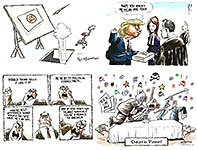
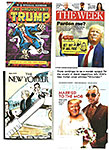


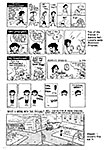

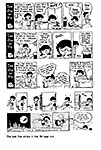

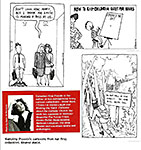
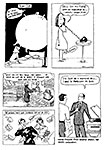
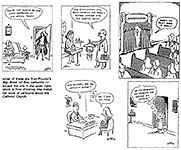
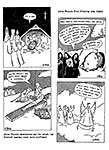
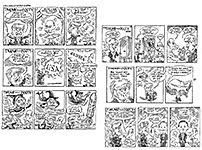
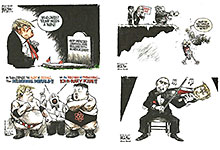
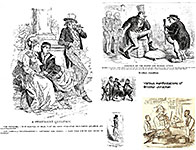
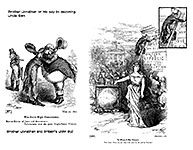
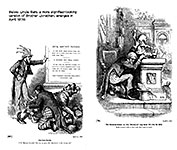

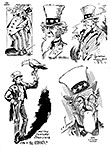

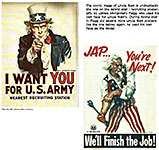

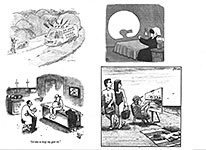
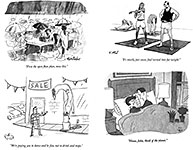
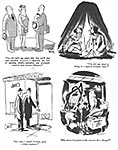
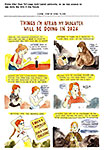
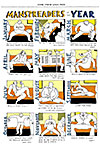
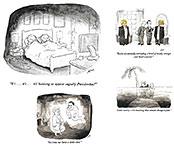
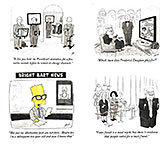
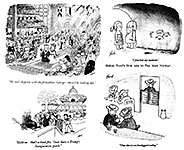
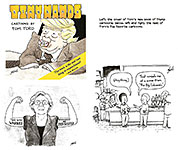
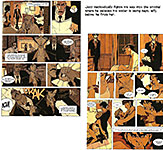
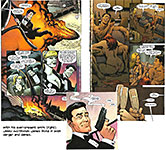

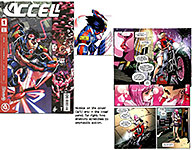

1.jpg)
2.jpg)
3.jpg)
4.jpg)
5.jpg)
6.jpg)
7.jpg)
8.jpg)
9.jpg)
10.jpg)
1.jpg)
2.jpg)
3.jpg)
4.jpg)
5.jpg)
6.jpg)
